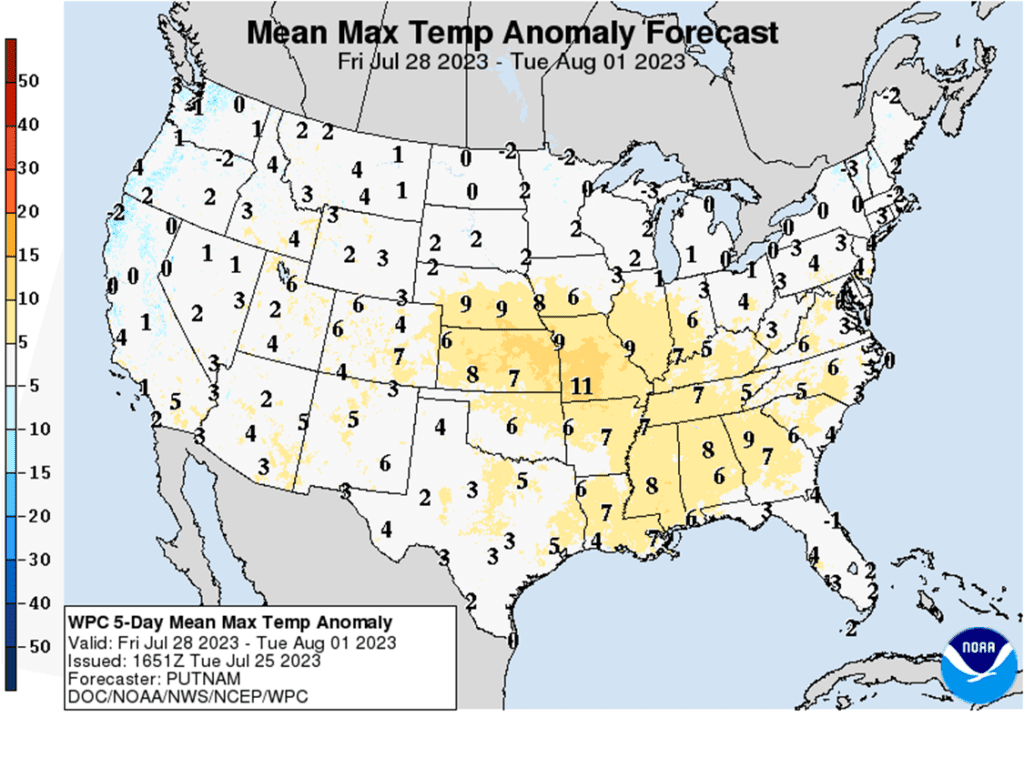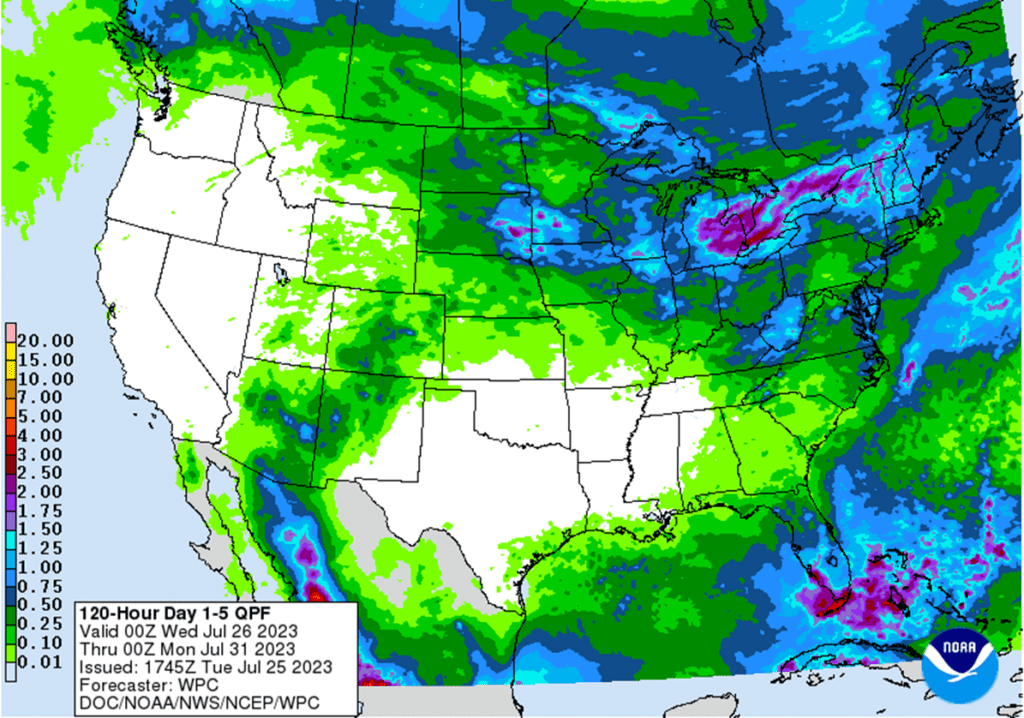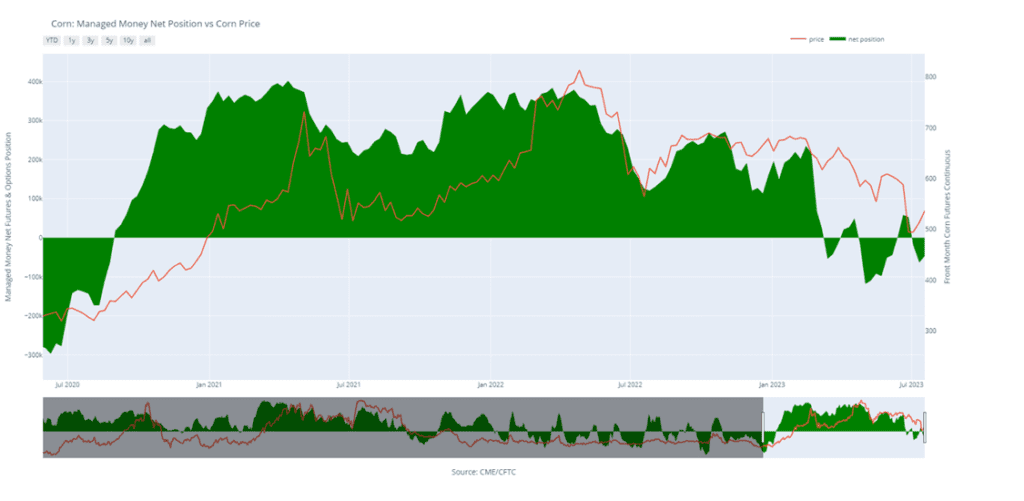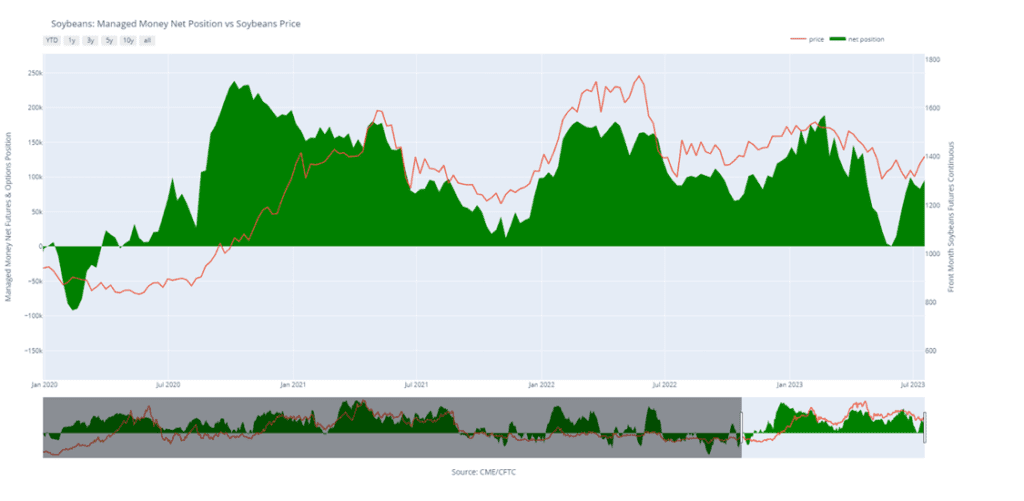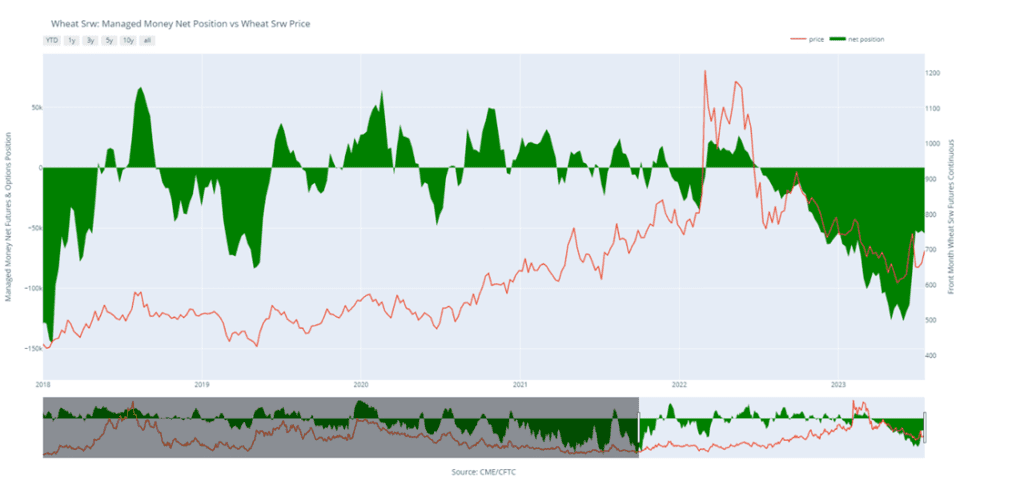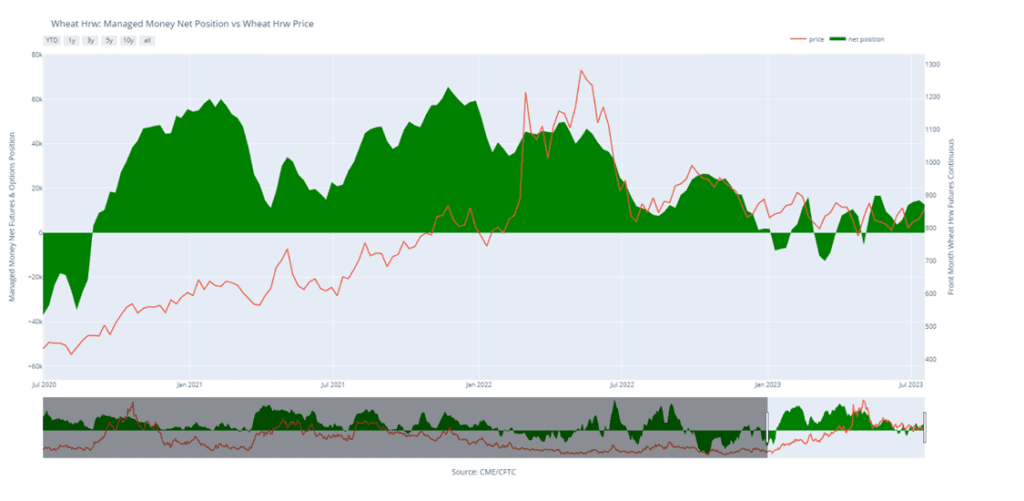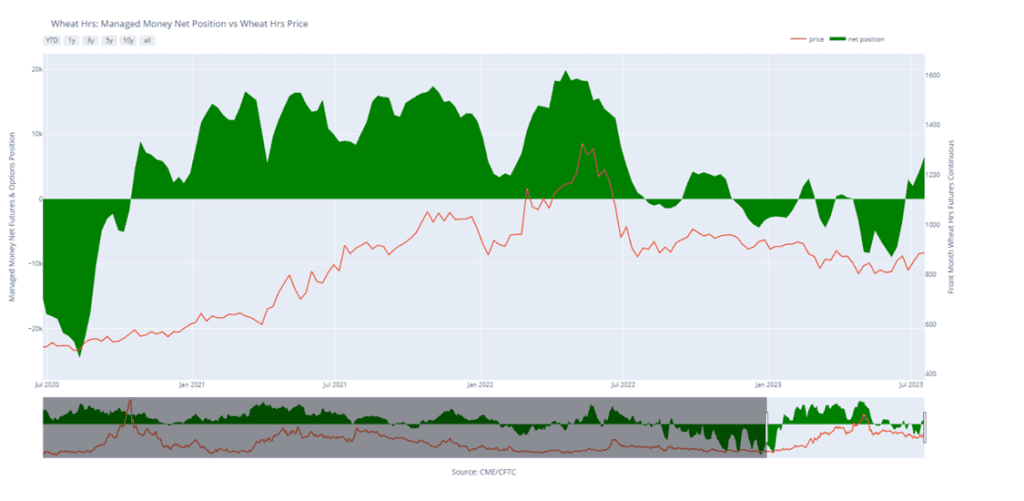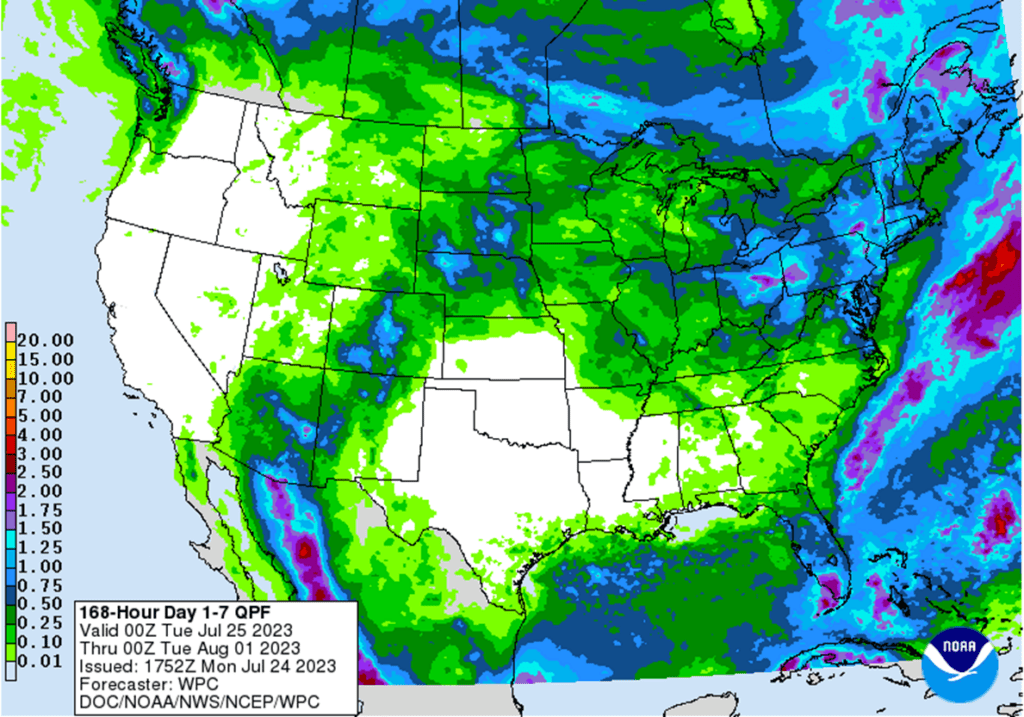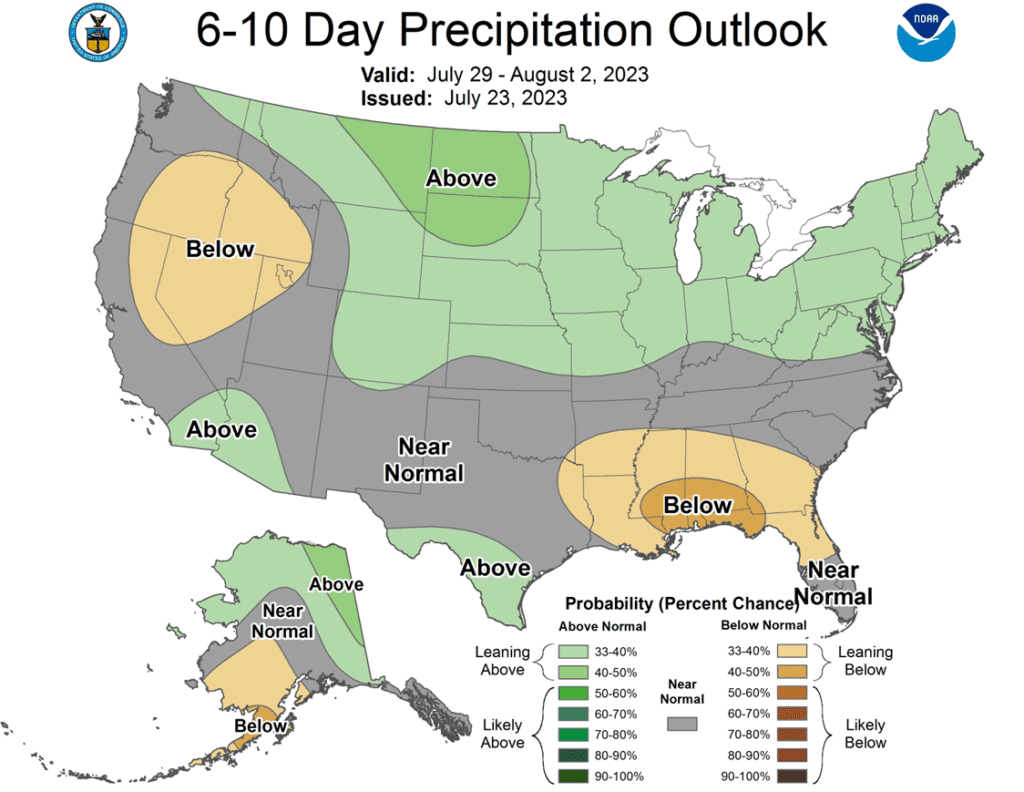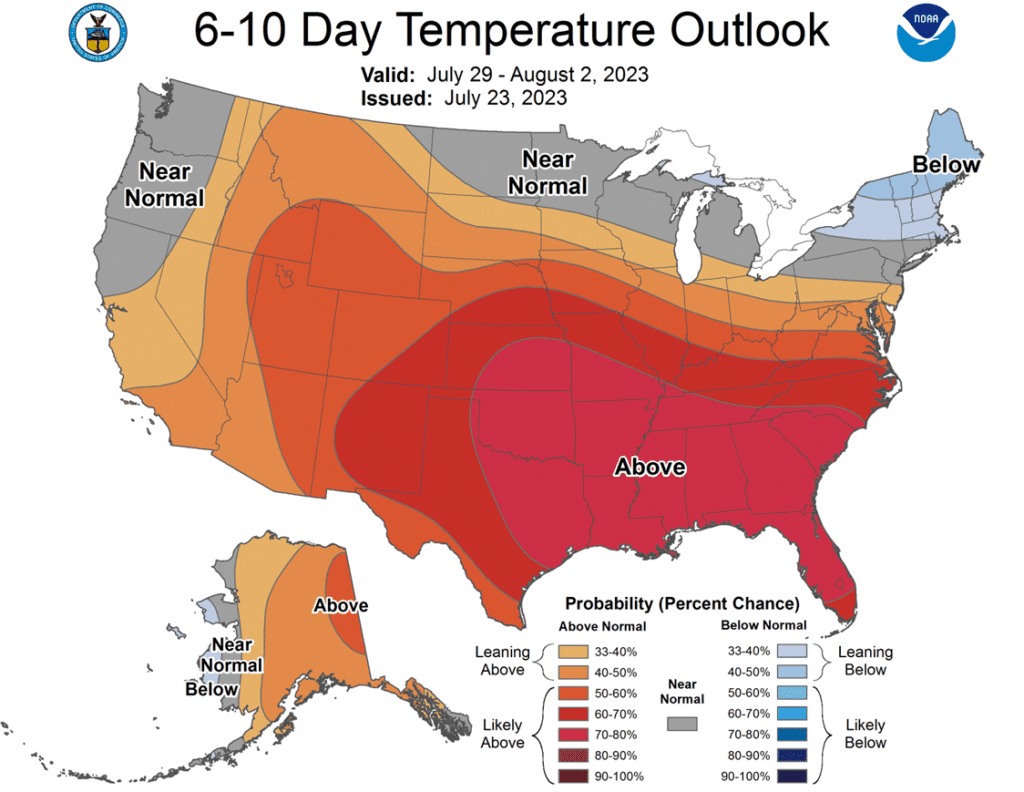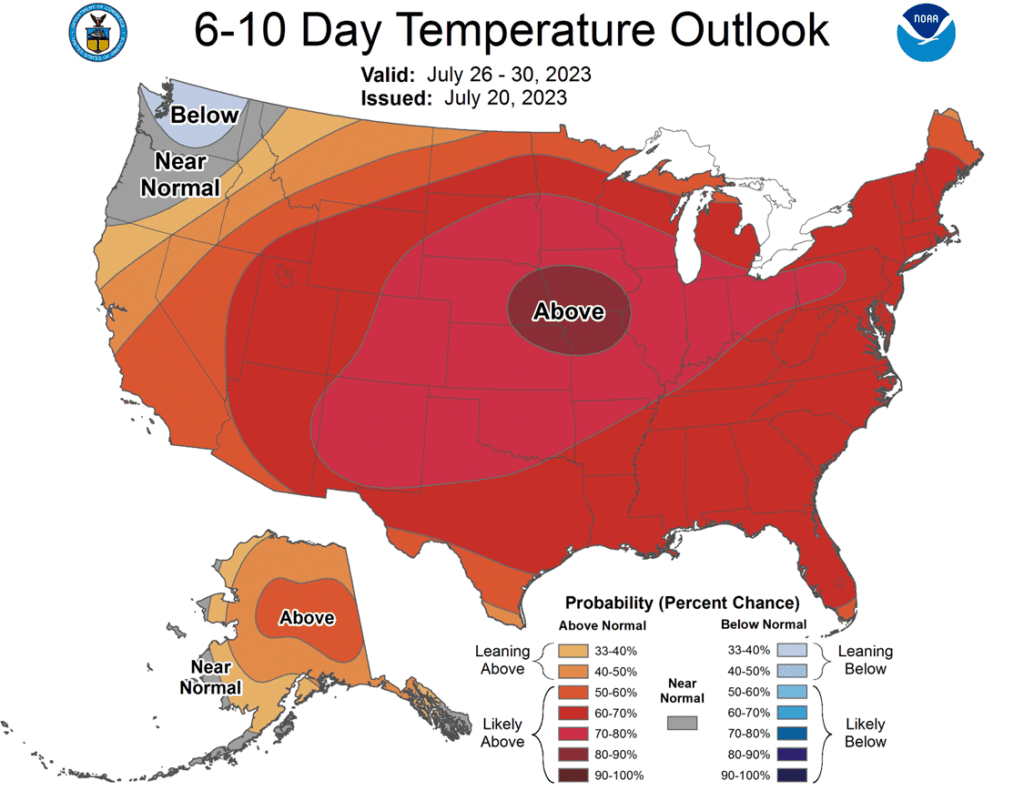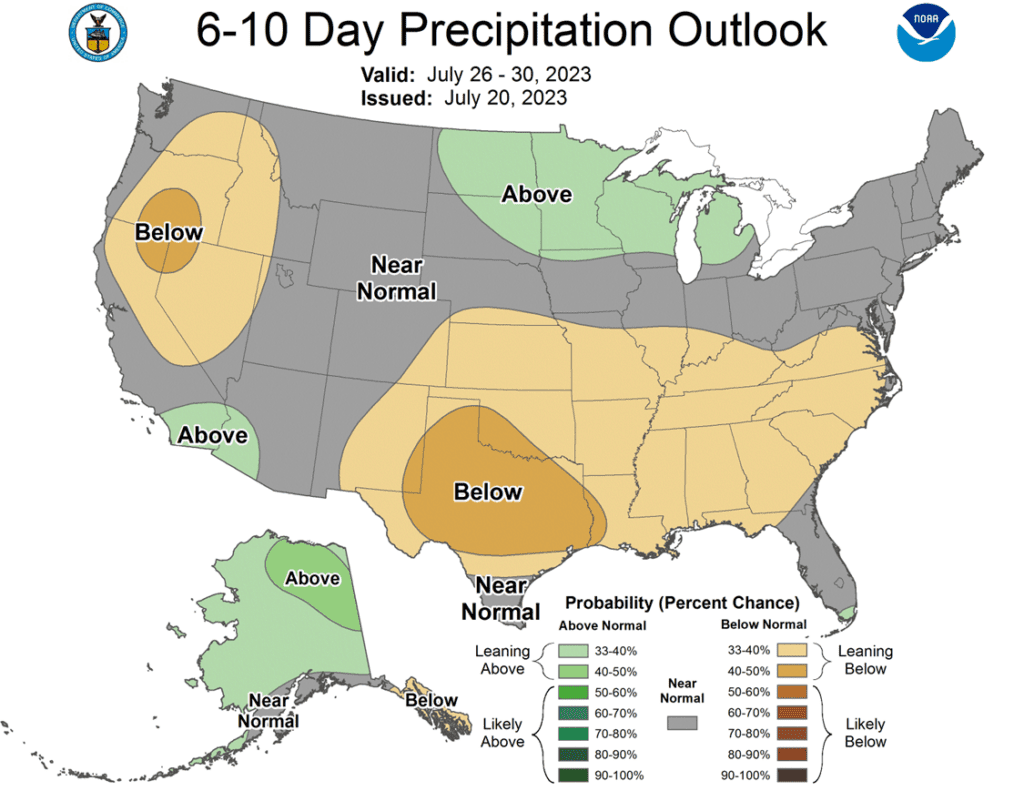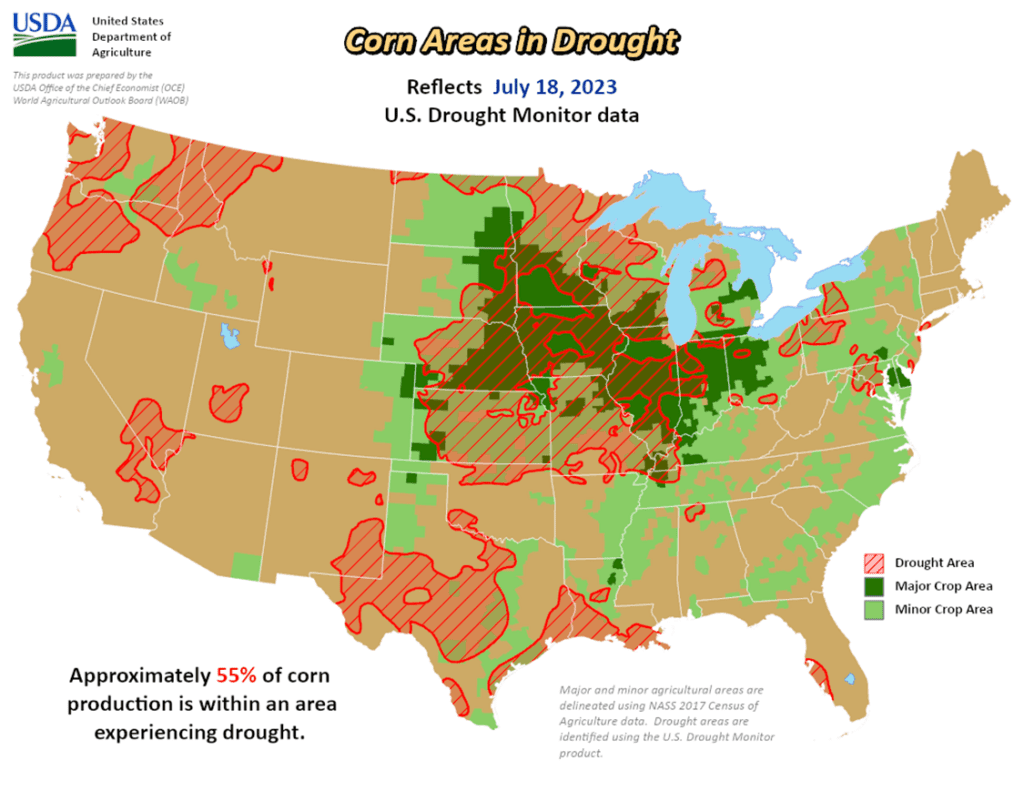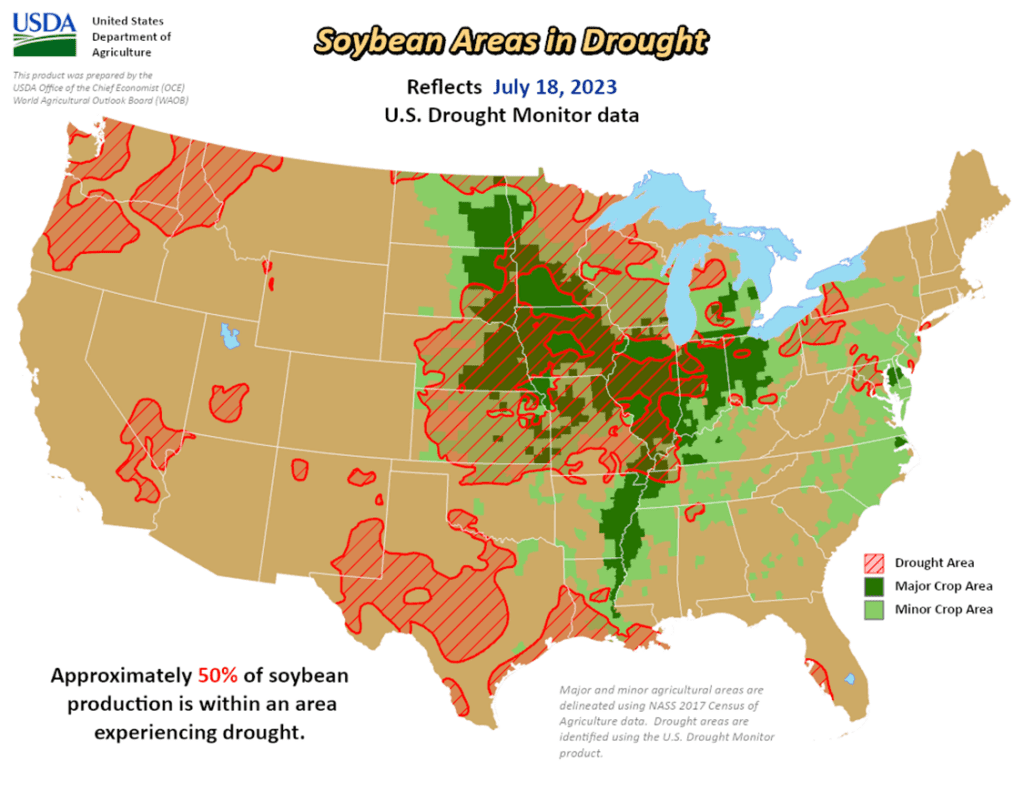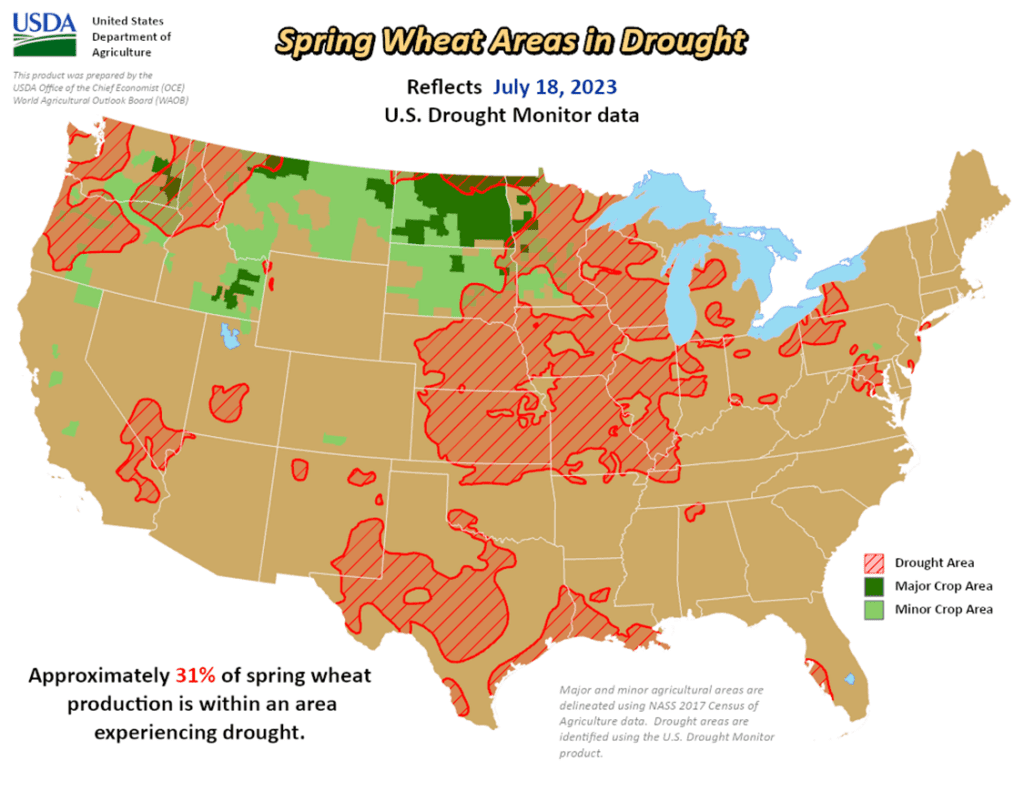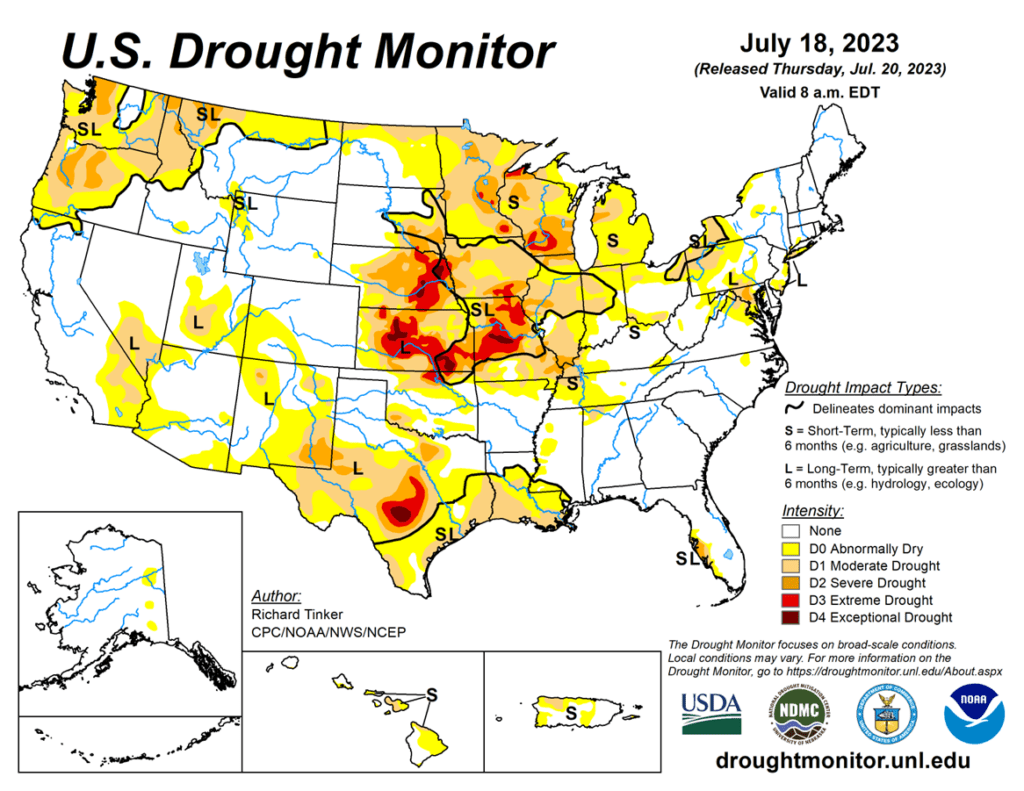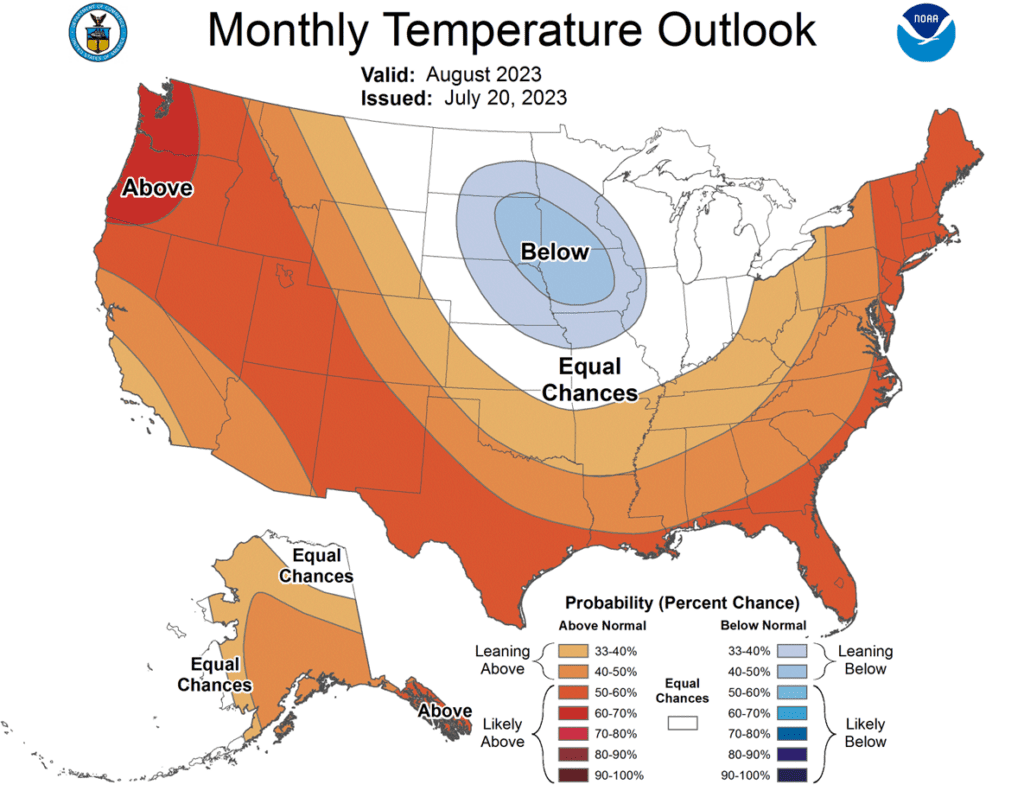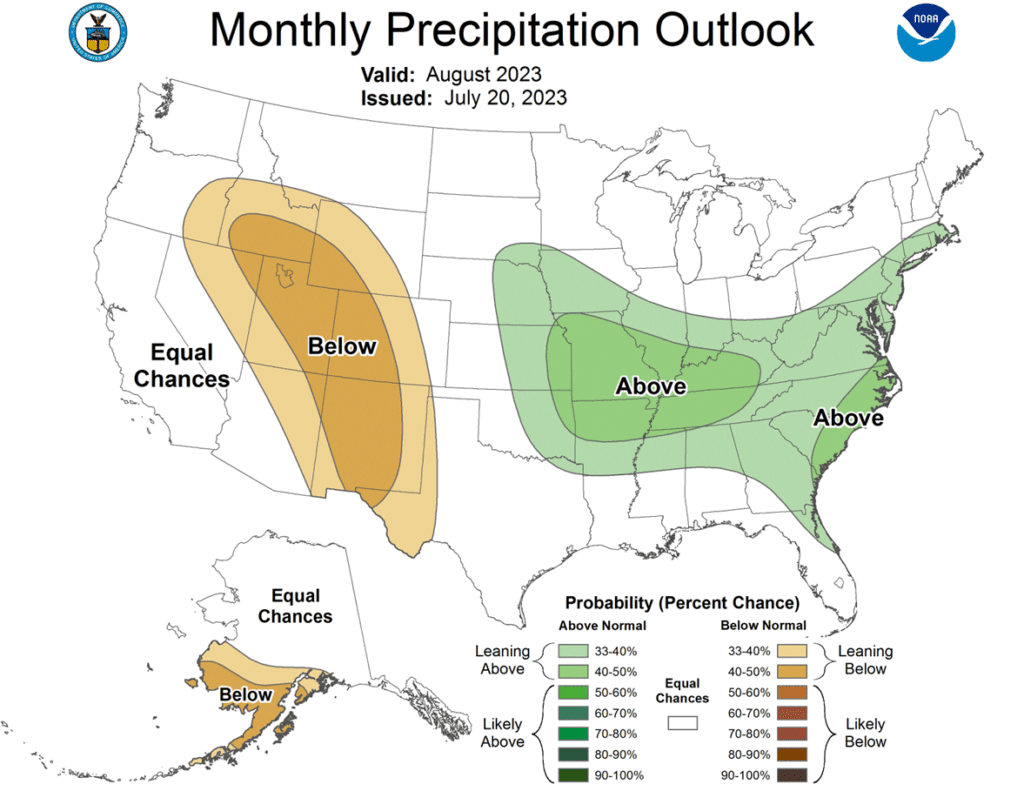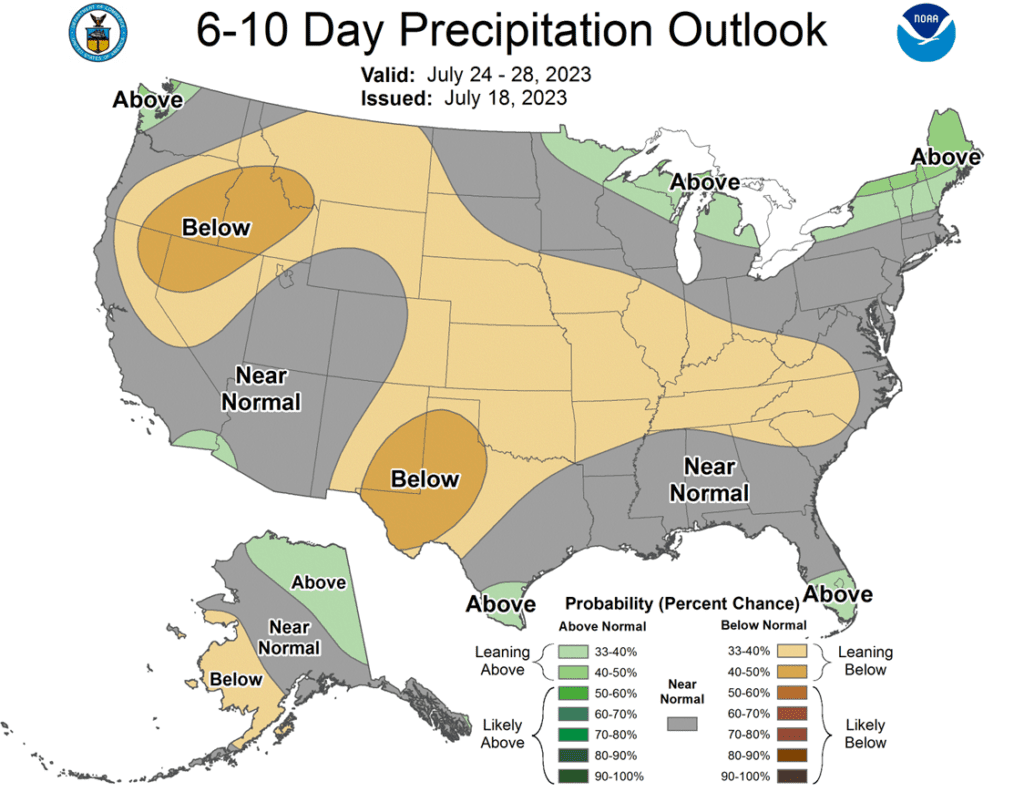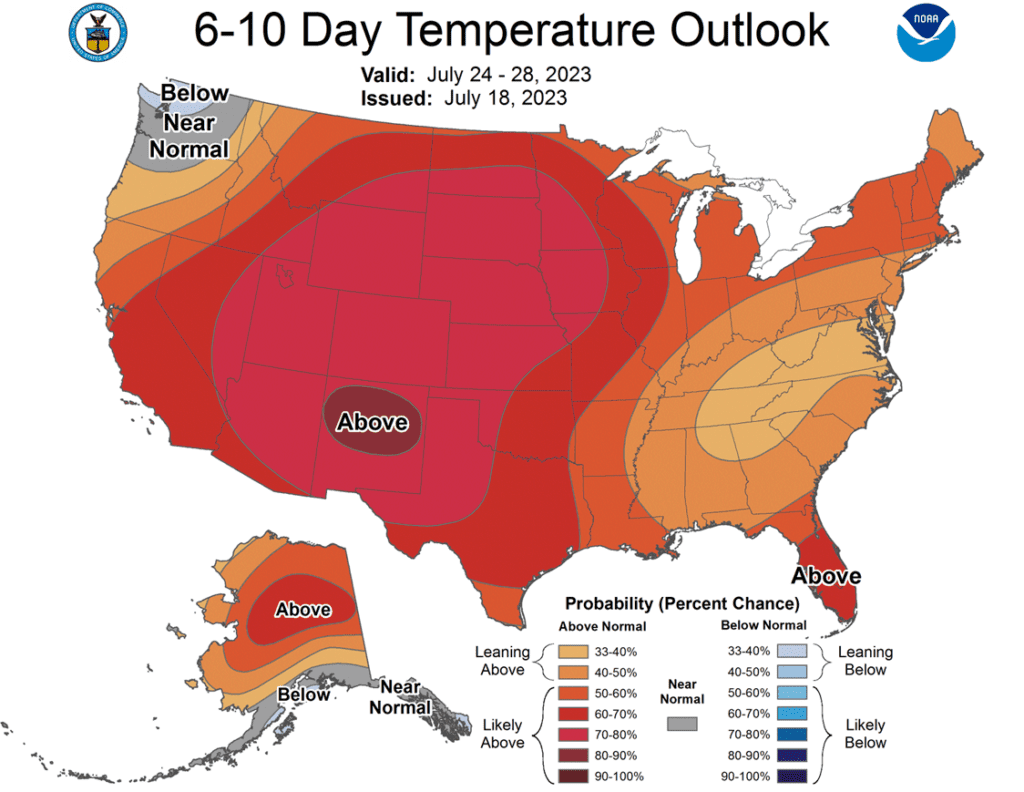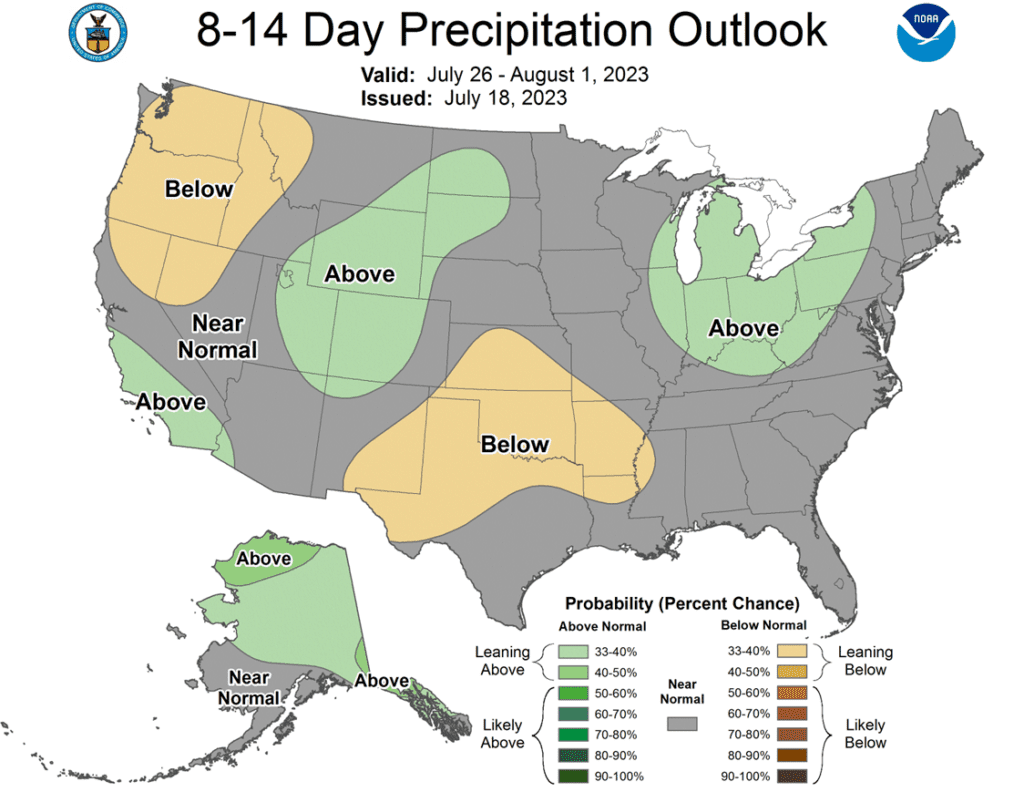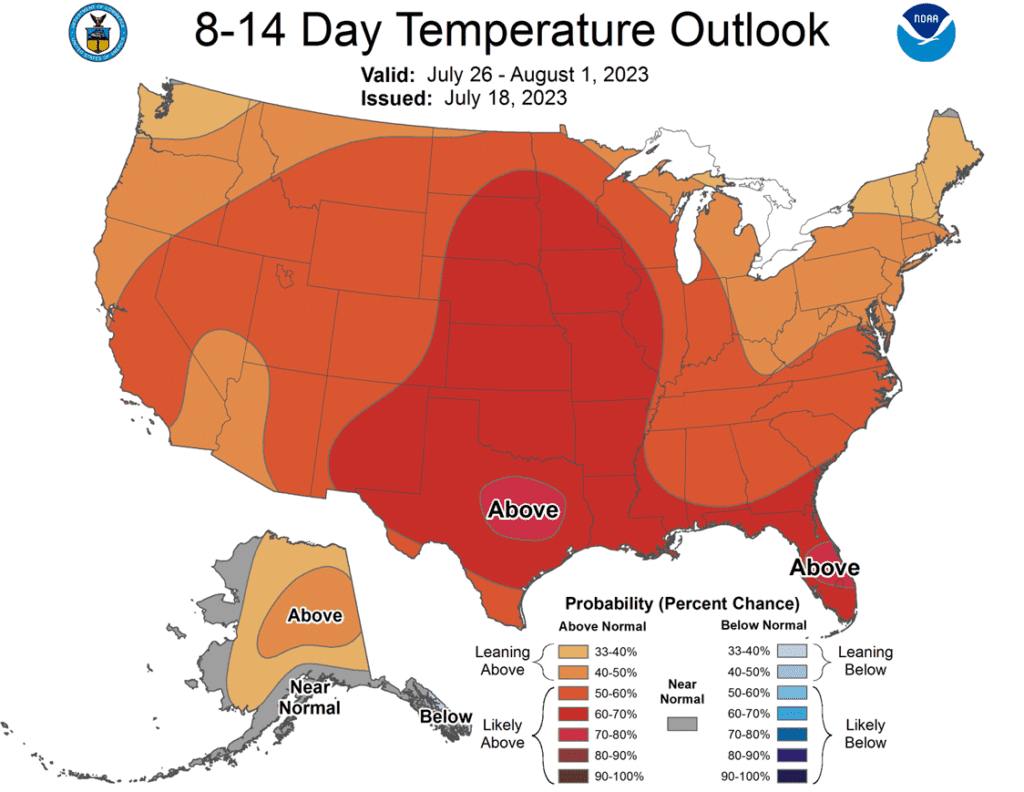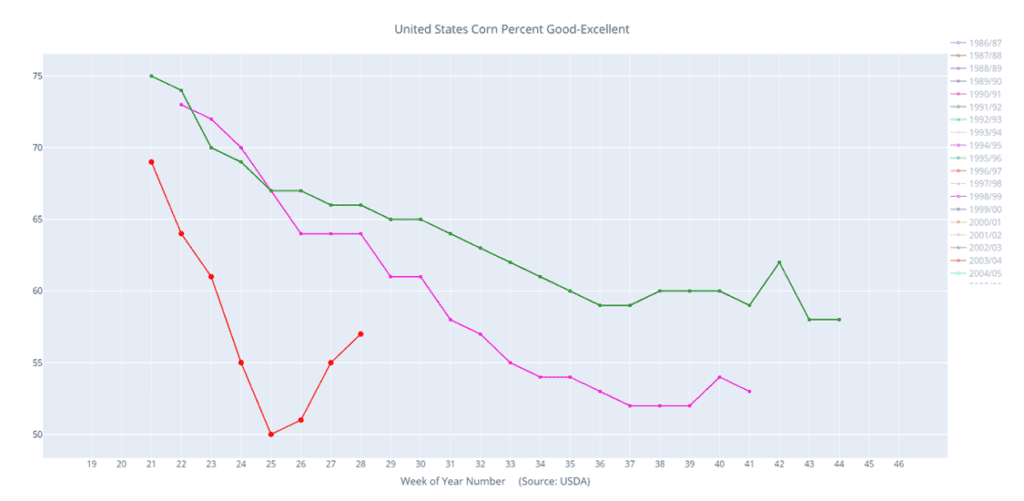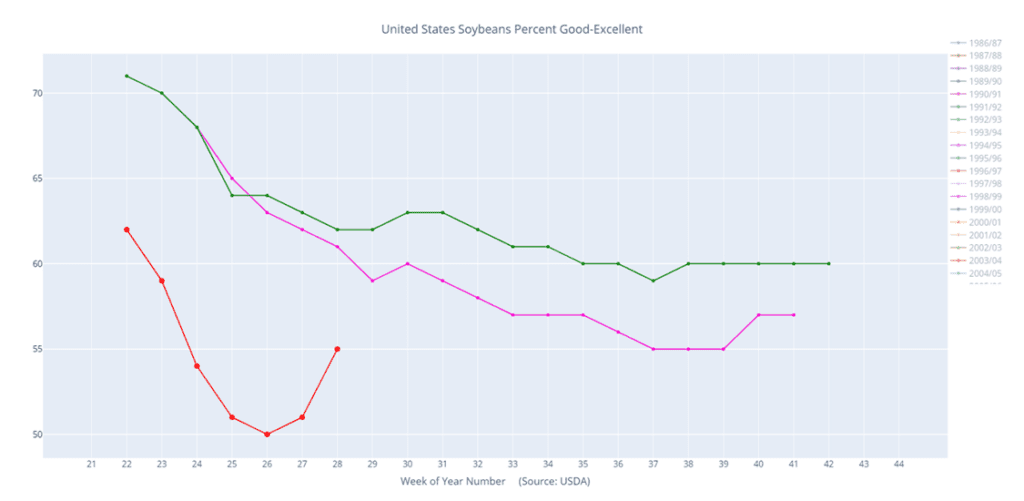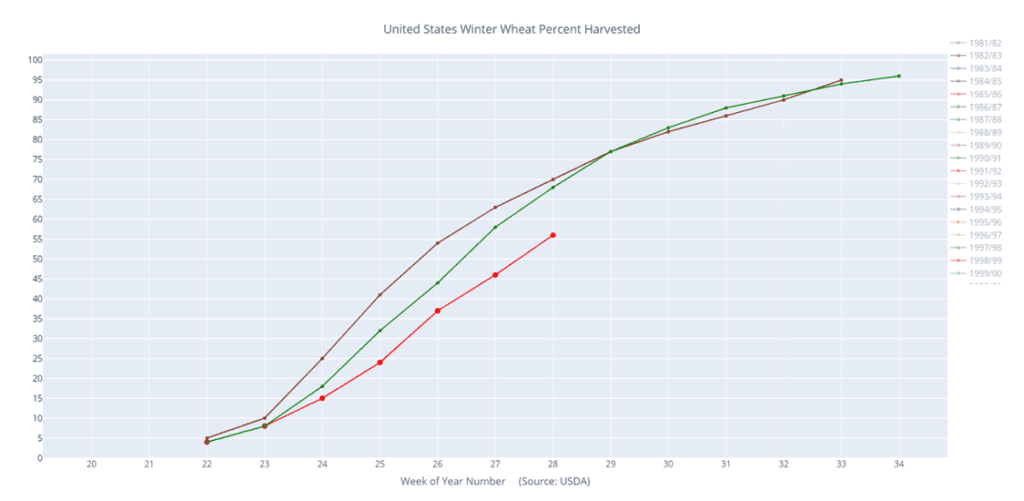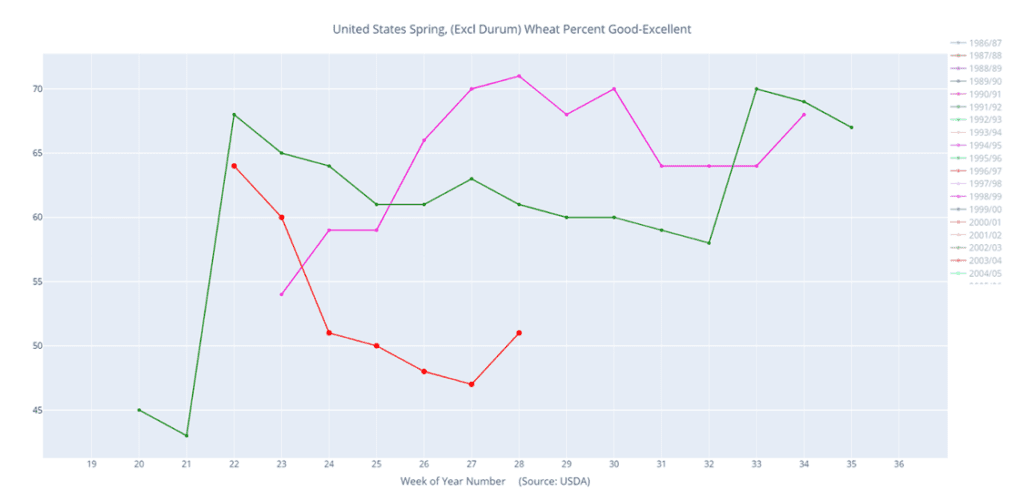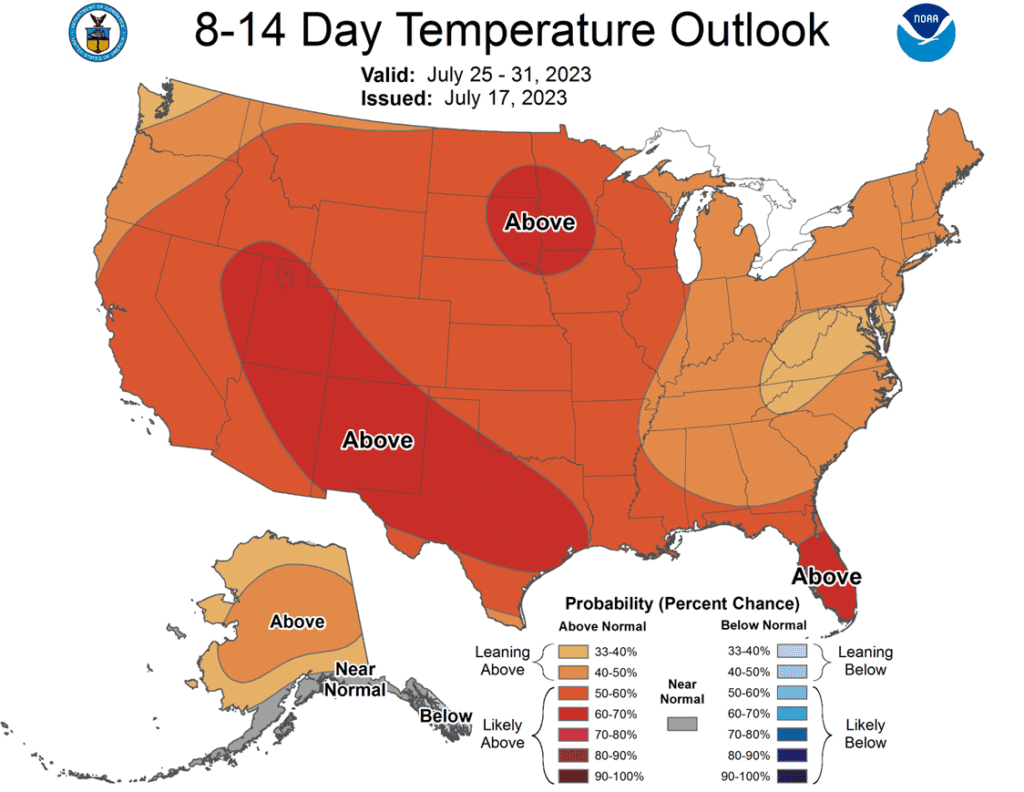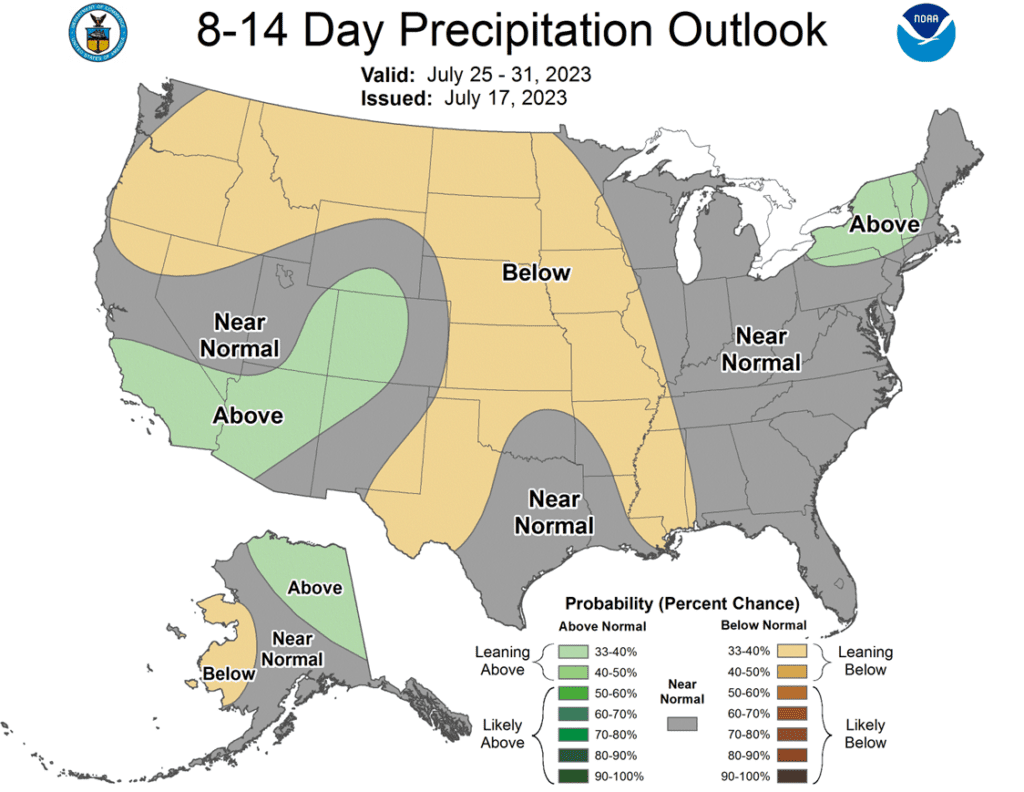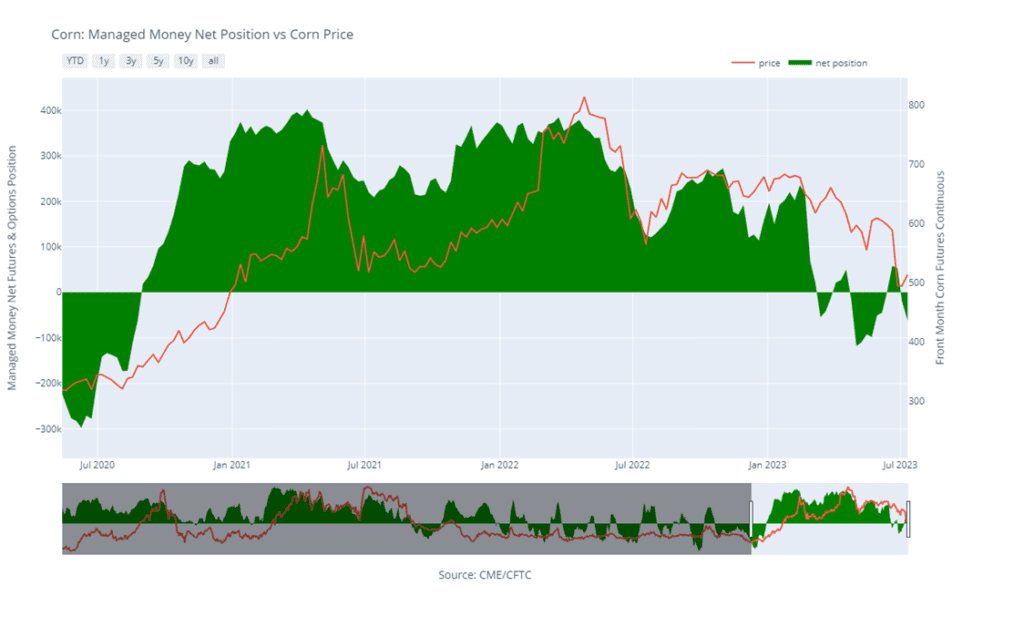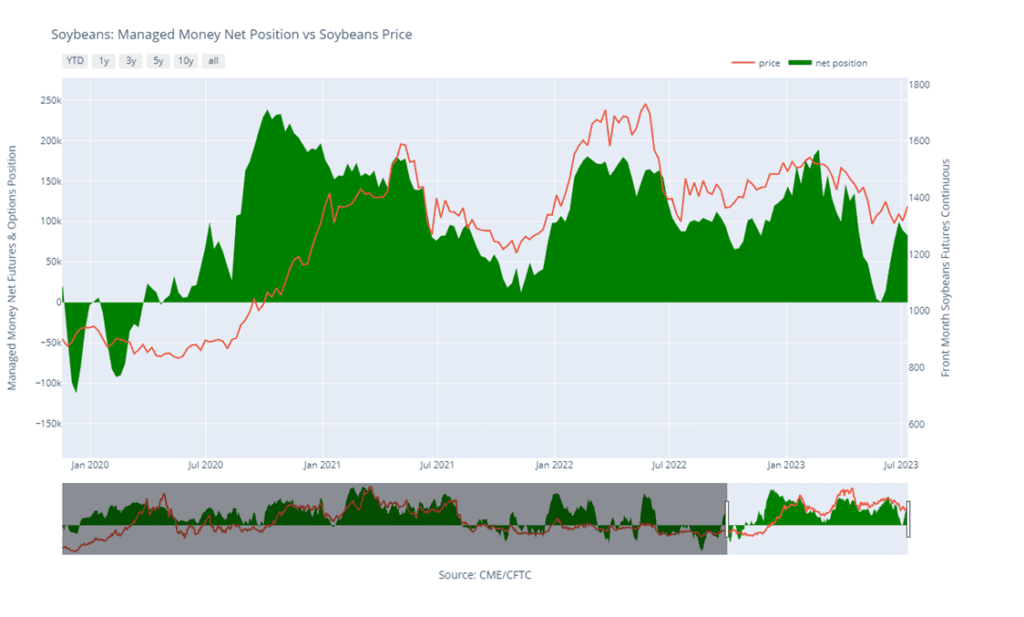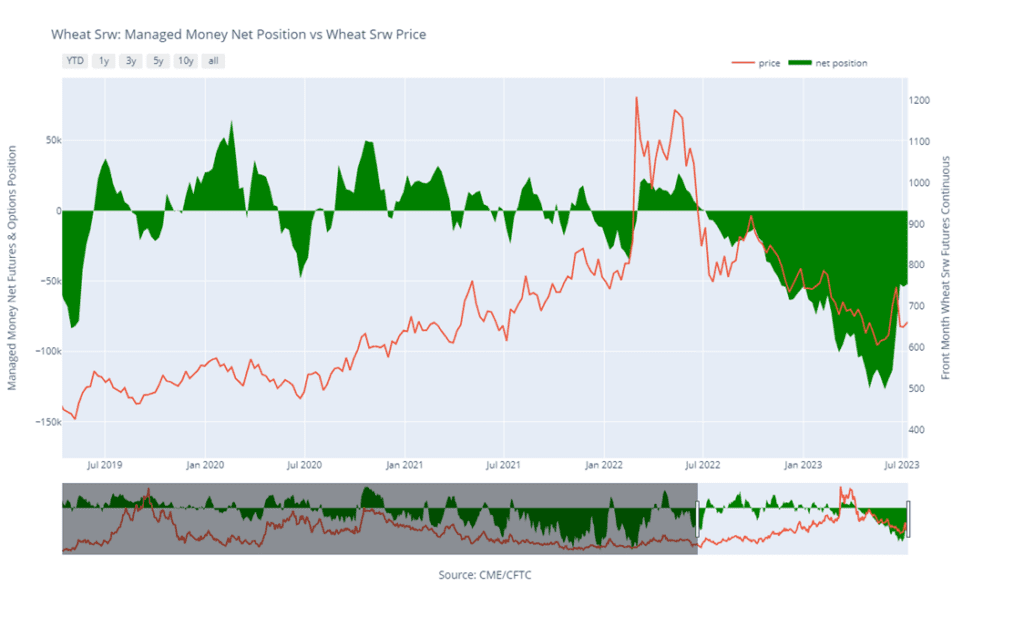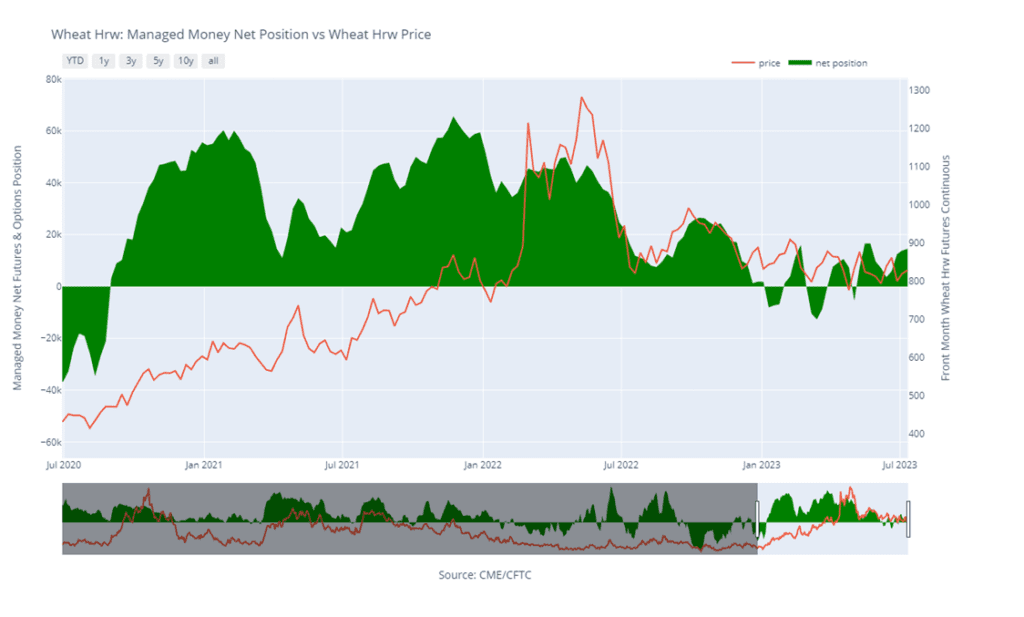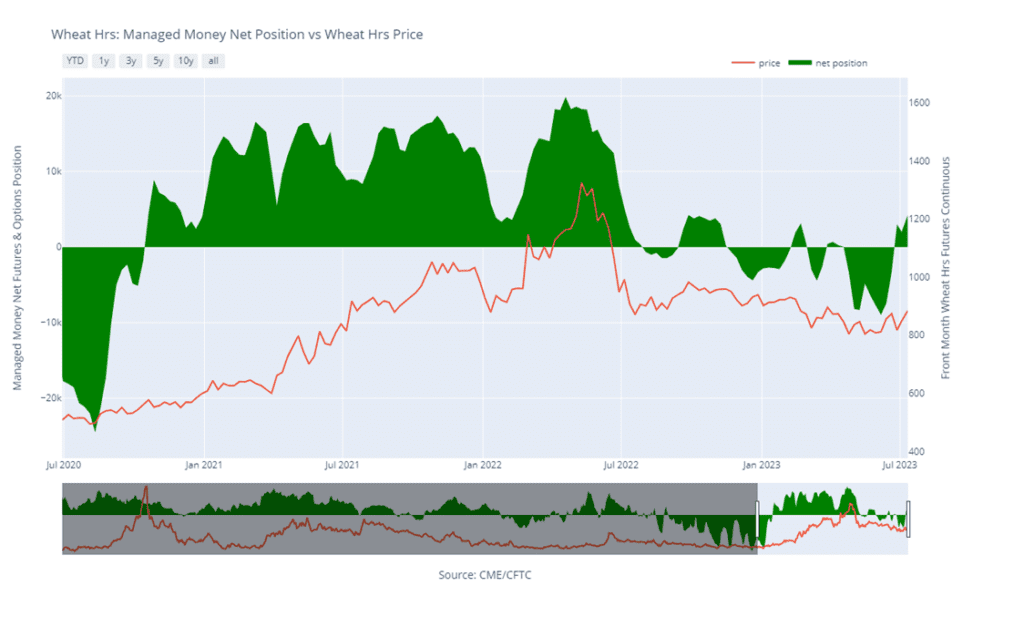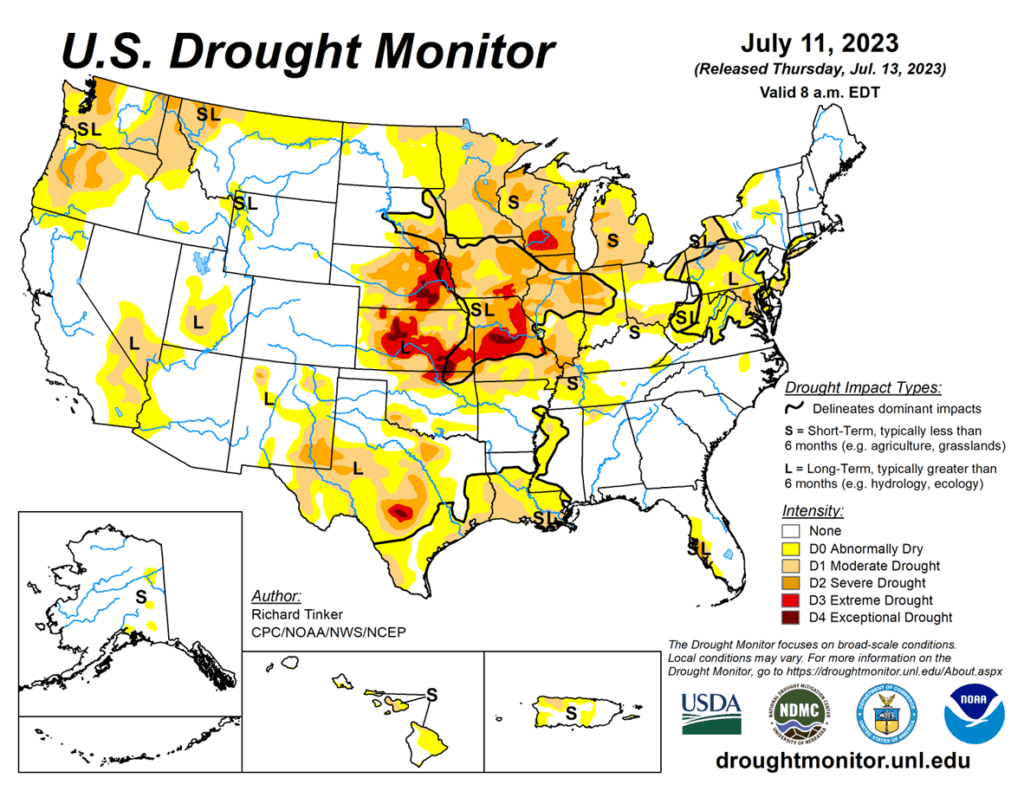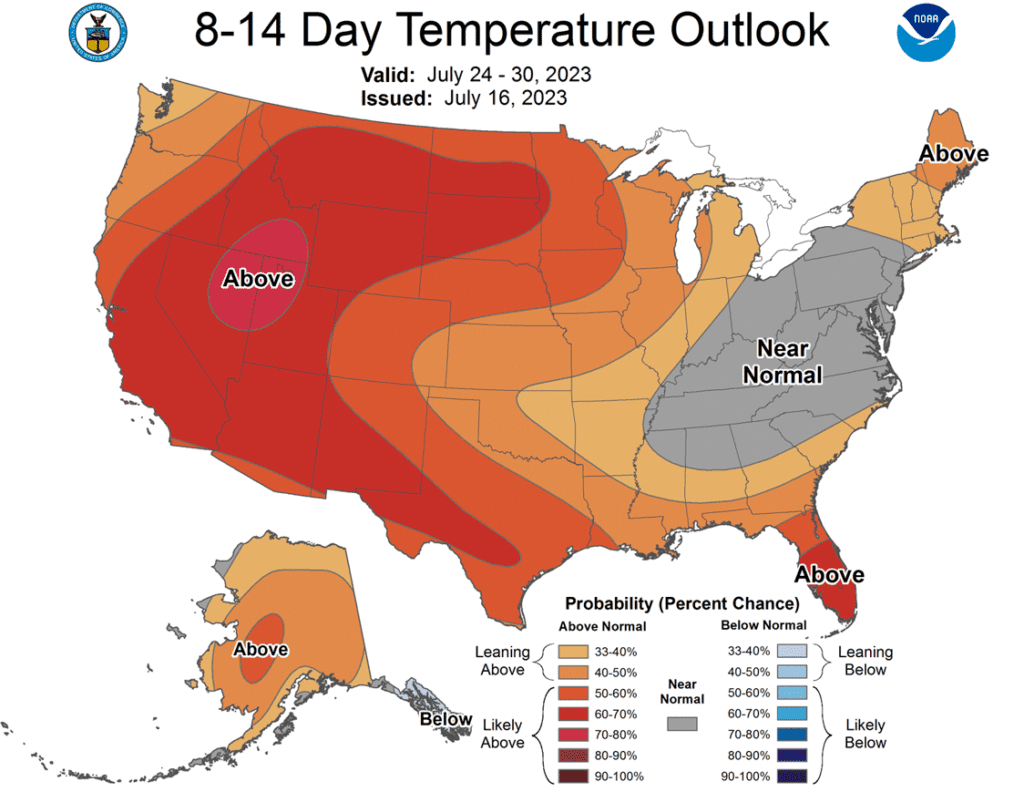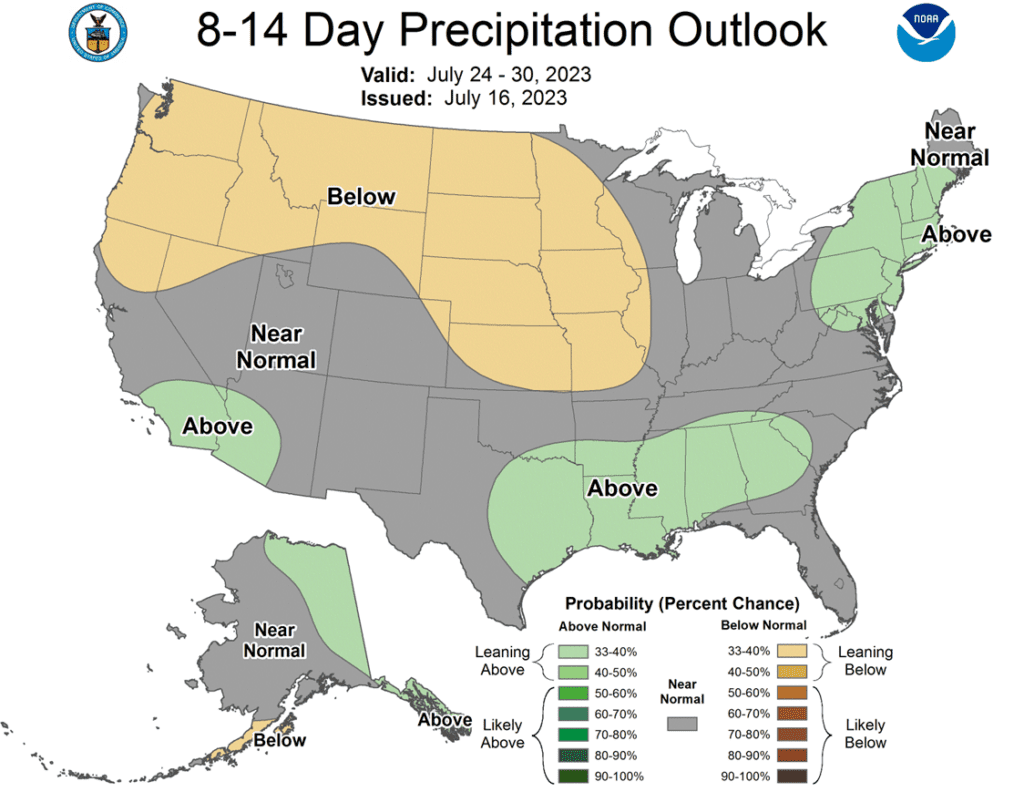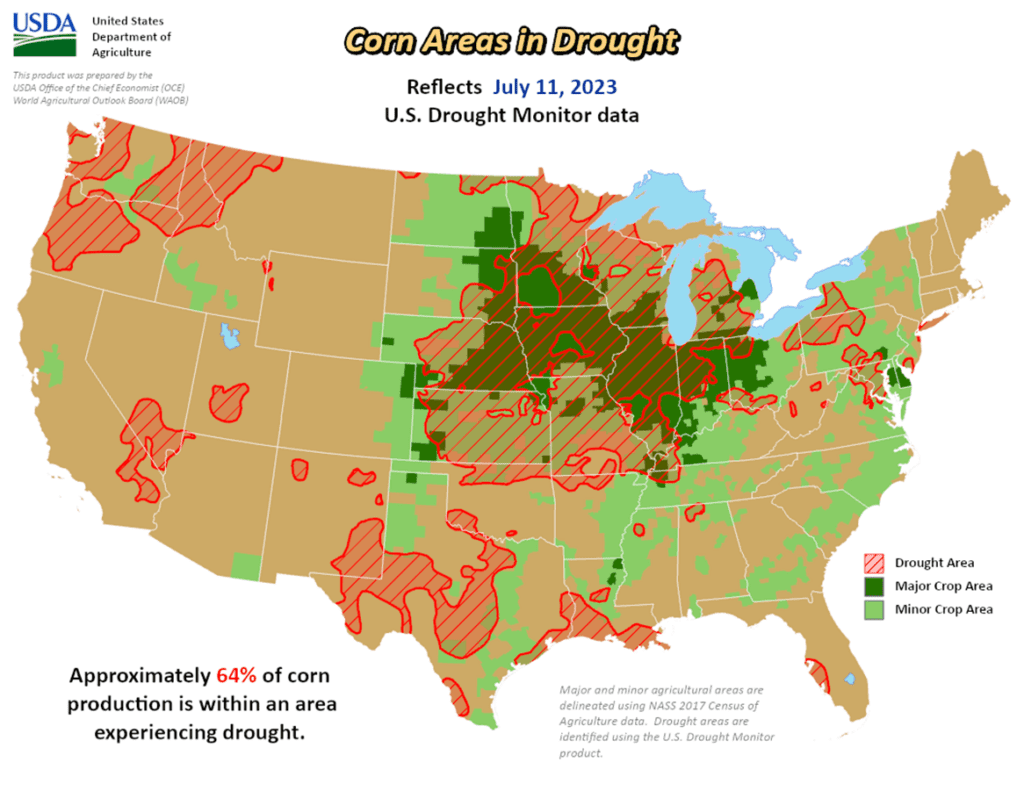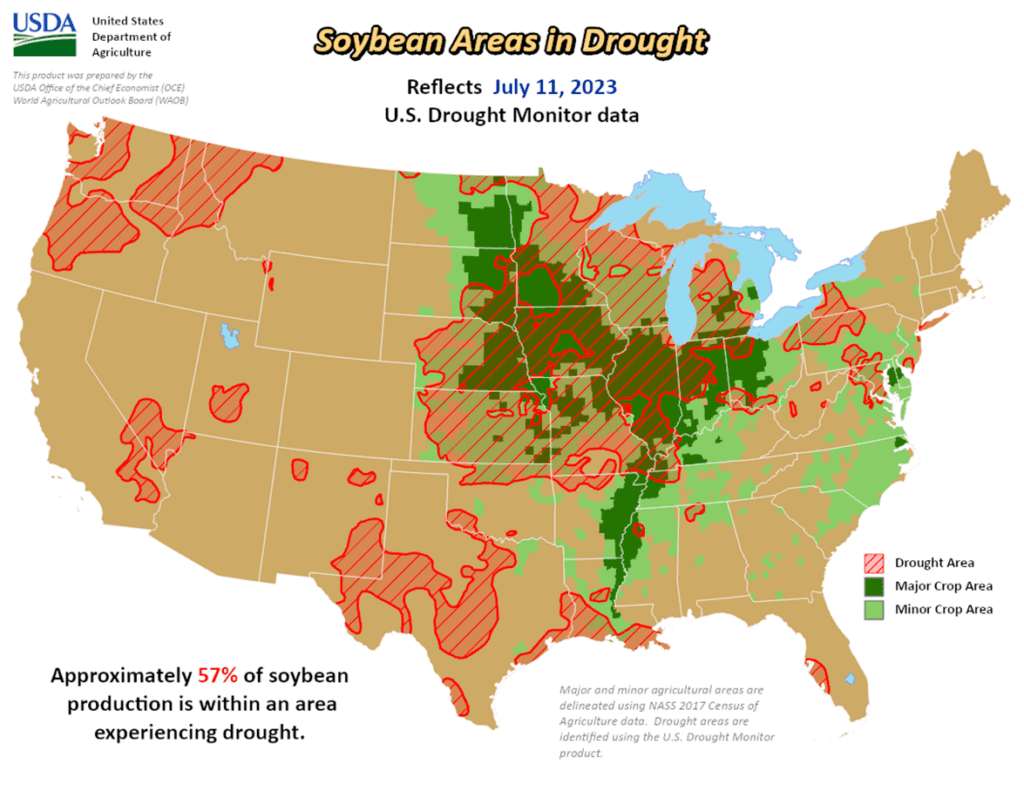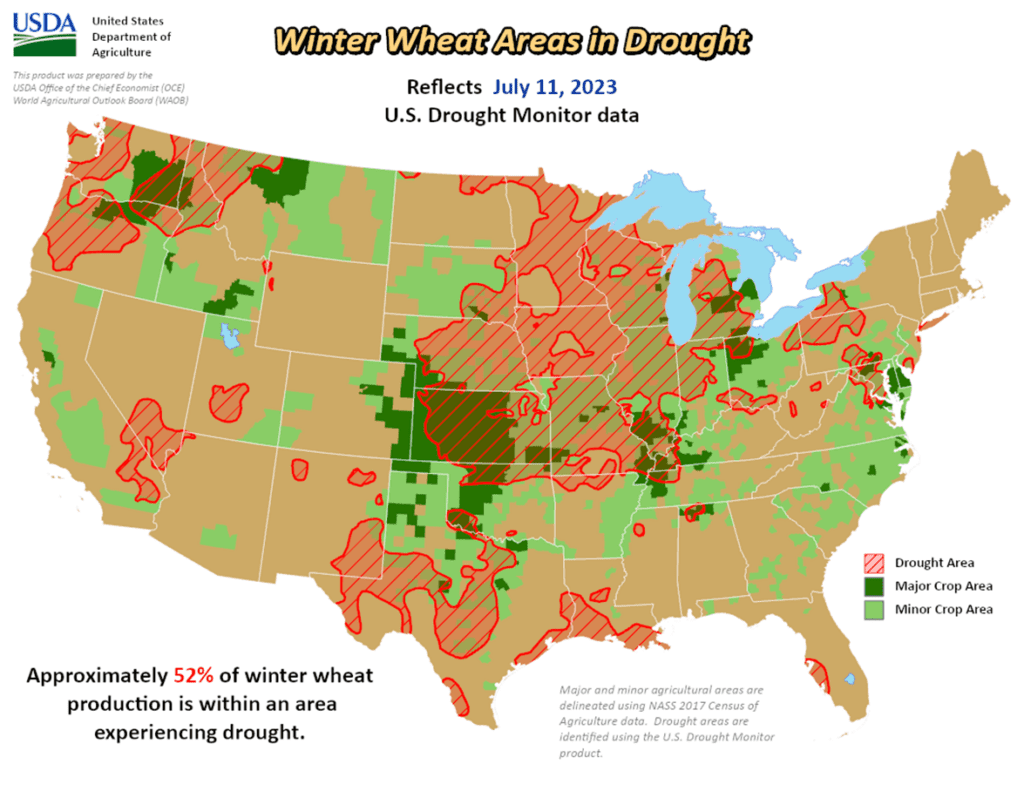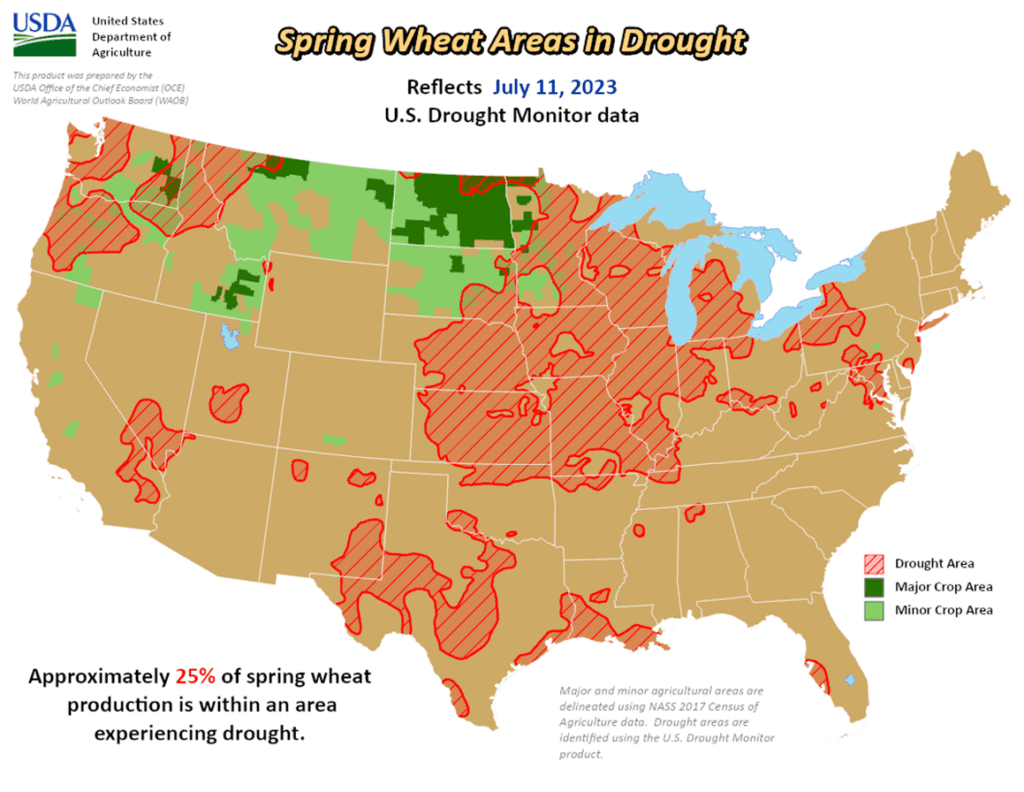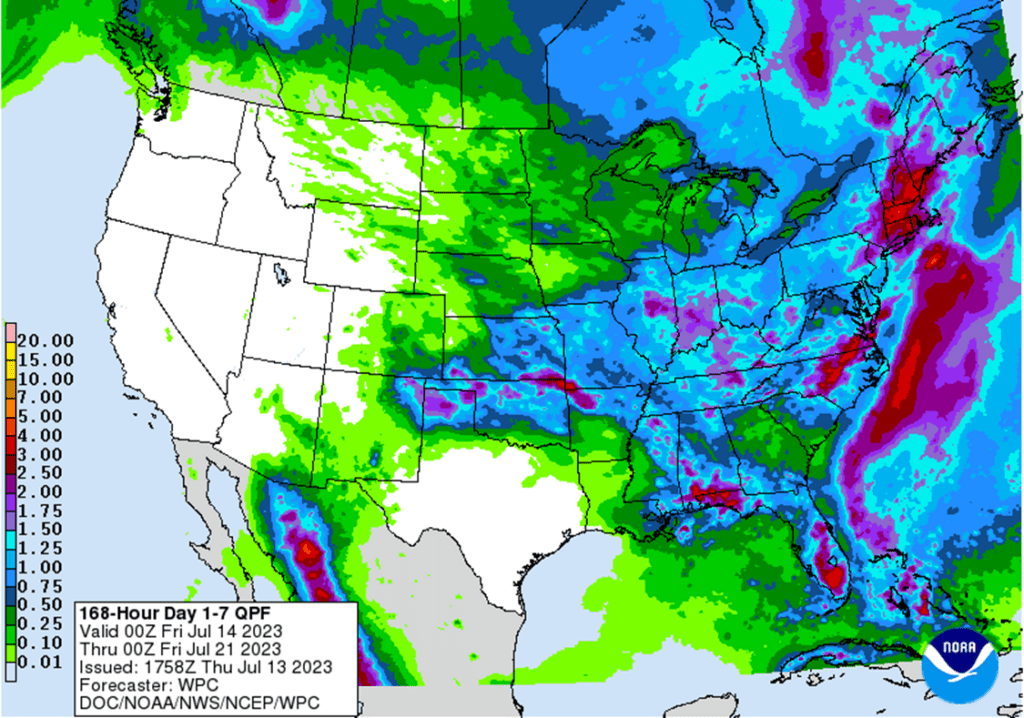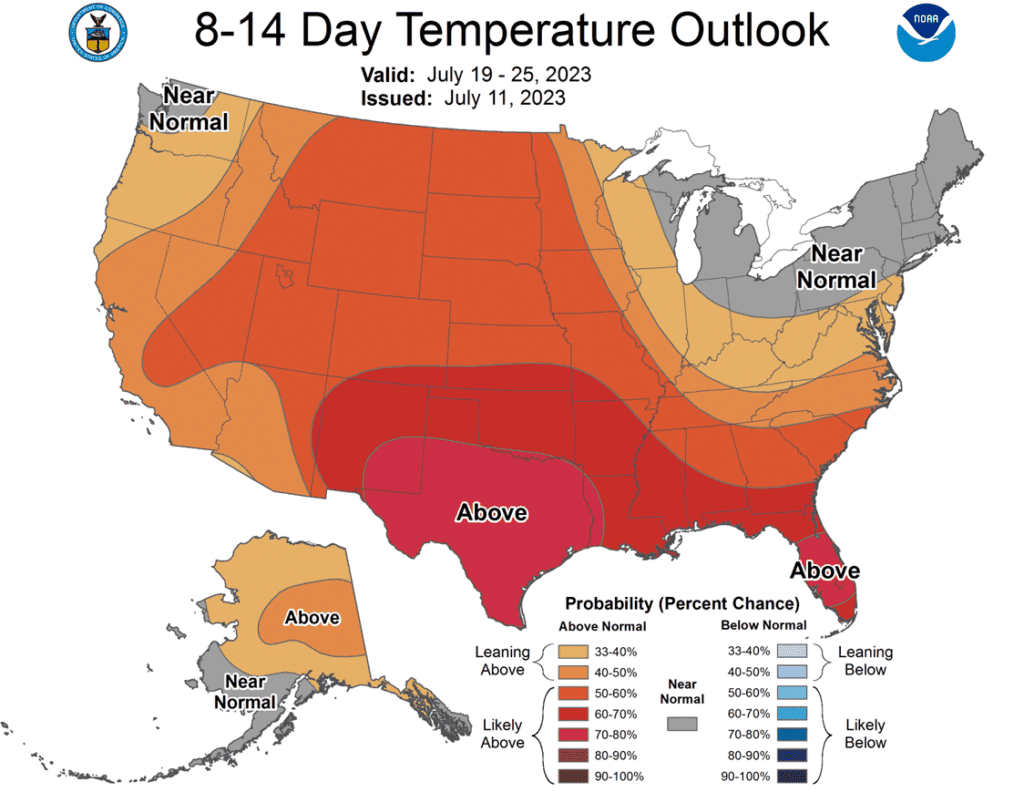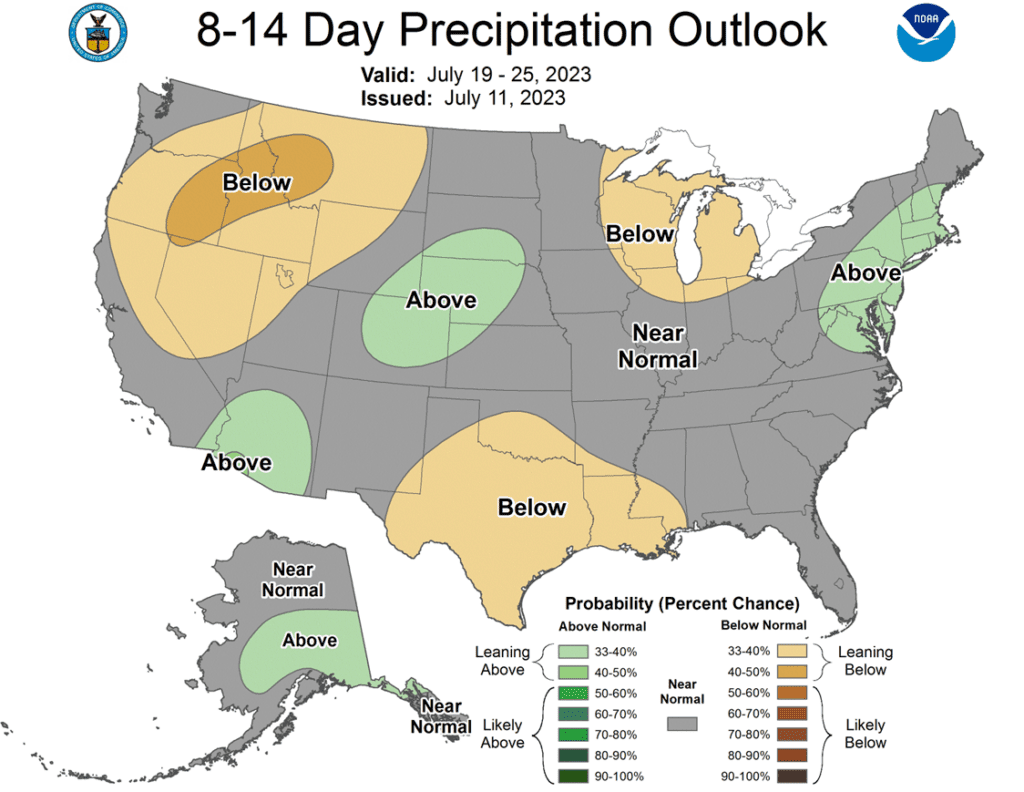Grain Market Insider: July 25, 2023
All prices as of 1:45 pm Central Time
Grain Market Highlights
- After trading both sides of unchanged in the overnight session, the corn market succumbed to “turn around Tuesday”, as the market consolidated following choppy trade in the wheat market.
- Despite lower crop ratings and a strong soybean meal market, soybeans consolidated from yesterday’s gains and followed soybean oil lower, although the November contract was able to close 17 cents off the day’s low.
- Choppy trade in the wheat markets with no new headlines of Russian attacks on Ukrainian grain facilities led the complex to close mixed. Chicago showed small gains, while both K.C. and Minneapolis contracts settled mixed with front months weaker and deferred months stronger.
- To see the current 5-Day Mean Temperature Forecast and 5-day precipitation forecast courtesy of the Weather Prediction Center, scroll down to the other Charts/Weather Section.
Note – For the best viewing experience, some Grain Market Insider content is best viewed with your phone held horizontally.
Corn
Corn Action Plan Summary
- No new action is recommended for Old Crop. The market had a nearly 140-cent swing from the May low to the June high and back on weather. Use any remaining bounces in the market to price what Old Crop bushels you may have, if any. We won’t have any “New Alerts” for 2022 Corn (Cash, Calls, or Puts) as we have moved focus onto 2023 and 2024 Crop Year Opportunities.
- No action is recommended for New Crop 2023 corn. The future price potential for Dec 23 corn continues to be at the mercy of each new weather forecast. Dryness and dry weather forecasts pushed Dec corn from the May low to the June high with a gain of 137 cents, which was promptly erased and then some by mid-July, leaving the market 149 cents off that June high, with a surprise jump in acres and more favorable forecasts. Now, the threat of dry weather again has rallied Dec corn more than 80 cents off that July 13 low. During the runup in early June, we warned that any change in the forecast to wetter weather could erase all the gains as corn didn’t have much of a bullish fundamental story without a supply-side shock fueled by lower yields. Overall, our thought process has not changed from a month ago and with the tremendous uncertainty, and subsequent volatility still in front of us, we continue to recommend holding the Strangle options position, comprised of the previously bought Dec 610 calls and Dec 580 puts. A turn back to wetter weather and we wouldn’t be surprised to see sub-500 corn again, and if dry weather persists, we wouldn’t be surprised to see corn prices north of 700. Under either of these scenarios, the Strangle will benefit and doesn’t require trying to outguess the weather.
- No action is currently recommended for 2024 corn. In 2012, the best pricing opportunities for Dec 2013 corn were during the 2012 summer runup. Despite the significant yield losses to the 2012 crop, and the fear of running out of corn, the Dec 2013 contract peaked in the summer of 2012, and by January 2, 2013, the price was already down about 12% from the high. We continue to watch the calendar for 2024 corn as this 2023 summer volatility could provide some additional opportunities to get some good early sales on the books in the event of a 2013-type repeat. Insider recently recommended making a sale on your 2024 crop, and we’ll be watching for another opportunity to suggest adding to prior early sales levels between now and the beginning of September.

- Corn futures saw consolidative trade on Tuesday as the market took a pause with choppy trade, as the wheat market led over the direction of the corn trade. Despite trading lower on the day, corn futures traded near the top end of the trading range towards the close on favorable price action.
- The USDA released weekly crop ratings on Monday afternoon. U.S. crop was rated 57% good to excellent, which was unchanged with last week and slightly below expectations. The rating was 4% below last year’s 61% good to excellent rating for the week.
- Hot weather forecasts support the market as high temperatures pushing into the 100-degree range will work into the Corn Belt. The excessive heat could impact yield with 68% of the corn crop in the silking stage. These high temperatures arrive in the key pollination window for many corn acres. Temperatures are expected to moderate next week.
- The wheat market is leading the corn market direction. Chicago wheat prices had a volatile session, but close above key resistance. The ongoing conflict in the Ukraine and the improved technical picture could trigger additional strength in the wheat market, which could spill over into the corn market, triggering additional short covering in the corn market.

Above: In mid-July the corn market was oversold and posted a double bottom at 474. Since then, it has rallied significantly toward the 50-day moving average. While the market has upward momentum, it may run into resistance near the 50-day MA. If the market closes above the 50-day MA, it could signal a change in trend to higher, though heavy resistance remains up towards 595 – 625 and it would need further bullish news to break through. Below the market, key support lies near the recent 474 low.

2023/24 Corn condition percent good-excellent (red) versus the 5-year average (green) and last year (pink).
Soybeans
Soybeans Action Plan Summary
- No new action is being recommended for Old Crop. Any remaining old crop bushels should be getting priced into this rally. We won’t have any “New Alerts” for 2022 Soybeans (Cash, Calls, or Puts) as we have moved focus onto 2023 and 2024 Crop Year Opportunities.
- No action is recommended for 2023 soybeans. The USDA injected a lot of volatility into this market beginning with a much lower-than-expected planted acreage estimate, followed by a much larger-than-expected 300mb carryout estimate in its July WASDE. While demand has been weak, we have a bona fide weather market during a crucial period for soybeans and there is little wiggle room for lost yield in this year’s crop. While a drier forecast can still maintain upside potential, plenty of time remains for rain to come and push prices lower, much like in 2012, when July was dry. Then the pattern changed in August, and decent rain fell in parts of the western Corn Belt and IL, sending Nov ’12 soybeans down 20%. For now, Insider may not consider suggesting any additional sales until after harvest. Although, we will continue to monitor the market for any upside opportunities in the coming weeks.
- No action is recommended for 2024 crop. Grain Market Insider continues to monitor any developments for the 2024 crop, though it may not be until after harvest or toward year’s end before we will consider recommending any 2024 crop sales.
- Soybeans ended the day lower, but came back significantly from the overnight lows. Soybean meal ended higher, while soybean oil was mixed with the two front months closing higher and the deferred months lower.
- The lows earlier in the day were partially a result of palm oil, which ended the day 2.3% lower, which then dragged down soybean oil. Soybean oil recovered on news that the number one veg oil importer, India, would import 46% more edible oils in July than the previous month.
- With the Black Sea grain deal ended and the fighting between Russia and Ukraine escalating, exporting sunflower meal and oil out of the region will be difficult, which should give support to soybean meal and oil, as India and other countries appear to be stocking up.
- The USDA released their Crop Progress report yesterday afternoon, which showed the soybean crop’s good to excellent rating slip by 1 point to 54% after heat and periods of dryness. 70% of the crop is blooming and 35% are setting pods, both figures are ahead of the yearly average. Missouri and Michigan received good to excellent ratings of only 27% and 33%, and the upcoming hot and dry forecast could significantly impact yields.

Above: The soybean charts rolled from the August to the September contract on 7/17 with the 75-cent discount to the September represented by the 52-cent gap on the chart between 7/14 and 7/17. To fill the gap, the market will need additional bullish news to continue higher and trade through the heavy resistance area of 1490 – 1505. If not, and prices retreat, initial support below the market is near 1400 with further support being in the 1350 – 1390 area.
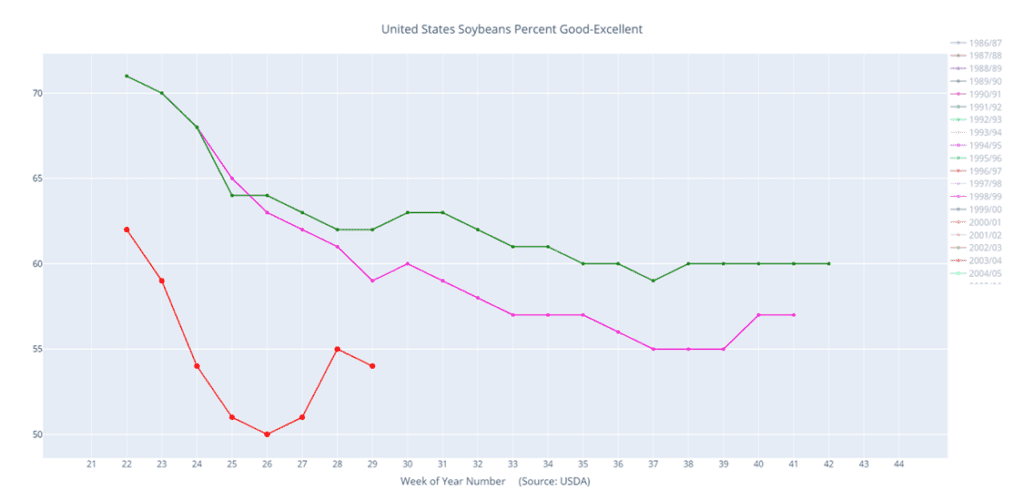
2023/24 Soybeans condition percent good-excellent (red) versus the 5-year average (green) and last year (pink).
Wheat
Market Notes: Wheat
- According to the USDA, the winter wheat crop is 68% harvested, still behind the average of 77% complete. Additionally, the spring wheat crop condition declined 2% from last week, now seen at 49% good to excellent.
- After trading both sides of unchanged, Chicago wheat posted small gains today. For the second day in a row, December Chicago wheat closed above the 200 day moving average, which it has not closed above since November 2022 (though it did trade above that level on June 26th).
- The market may have taken a bit of a breather today, with no headlines of new Russian attacks. The grain warehouses and infrastructure that were recently damaged along the Danube River does raise the question as to how much grain Ukraine will be able to export though. After the attacks, 30 vessels are said to be stranded along the river.
- Russia’s internal wheat prices are said to be surging, but they remain the world’s cheapest source of wheat, now seen at $242 per metric ton.
- Russia’s Deputy Foreign Minister, Sergei Vershinin, stated that there are currently no talks in regard to resuming the Black Sea Grain initiative. Since the closure of the deal, Ukraine has asked the European Union for an increased volume of shipments via alternative routes / methods. Several surrounding nations still have a ban on Ukrainian grain imports, however.
Chicago Wheat Action Plan Summary
- No new action is recommended for 2023 New Crop. The wheat market has seen a great amount of volatility in recent weeks and has primarily been a follower of corn which has been driven by weather. Although demand remains weak, the recent closure of the Black Sea corridor, and continued weather concerns in the northern Plains, Canada, Europe, and Russia, still leave many supply questions unanswered. While Grain Market Insider will continue to monitor the downside for any violation of major support following the recent sales recommendation, it may be after harvest or near the end of summer before we consider recommending any additional sales for the 2023 crop.
- No action is currently recommended for 2024 Chicago wheat. Since the middle of June, price volatility has risen with updated USDA reports, changing weather forecasts, and current events in the Black Sea. While prices continue to be volatile, plenty of time remains to market the 2024 crop. War continues in the Black Sea region, major exporting countries’ stocks are at 11-year lows, and no one knows what the weather will bring, leaving the market vulnerable to many uncertainties. For now, after recommending making a sale for the 2024 crop, and while keeping an eye on the market to see if any major support is broken, Grain Market Insider would need to see prices north of 800 before considering recommending any additional sales.
- No Action is currently recommended for 2025 Chicago Wheat. 2025 markets are very illiquid right now, and it may be some time before conditions are conducive to consider making any recommendations. Be patient as we monitor the markets for signs of improvement.

Above: Rising tensions in the Black Sea have fed the rally that tested the June high. Though the market is becoming overbought, further uncertainty or bullish input could push prices towards resistance near February’s high of 807-1/2. If prices do retreat, initial support may be found near 690 – 700, and again around 610 – 650.
KC Wheat Action Plan Summary
- We continue to look for better prices before making any 2023 sales. While crop conditions have improved and there are reports of better-than-expected US yields, questions remain about the world wheat supply with the closure of the Black Sea corridor, dryness in Russia, the Canadian Prairies/Northern US Plains, and Europe. With world supplies currently seen at 11-year lows, we continue to target 950 – 1000 in the July futures as a potential level to suggest the next round of New Crop sales.
- Patience is warranted for the 2024 crop. With continued issues in the Black Sea region and with major exporting countries’ stocks at 11-year lows, we are willing to be patient with further sales of New Crop HRW wheat. We are targeting just below the 900 level on the upside while keeping an eye on recent lows for any violation of support.
- No Action is currently recommended for 2025 KC Wheat. 2025 markets are very illiquid right now, and it may be some time before conditions are conducive to consider making any recommendations. Be patient as we monitor the markets for signs of improvement.

Above: K.C. wheat continues to be volatile and is testing the upper end of the trading range established back in May. With heavy resistance remaining near 920, the market will need additional bullish input to push higher and test the 966 – 991 range. Below the market, initial support is near 830 – 842, with further support near 763 – 778.
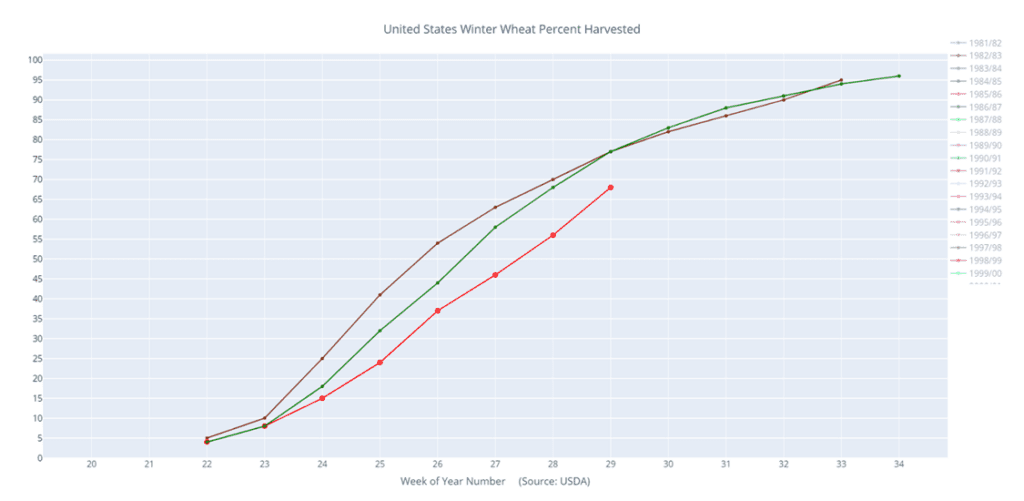
2023/24 Winter wheat percent harvested (red) versus the 5-year average (green) and last year (purple).
Mpls Wheat Action Plan Summary
- No new action for 2022 Old Crop MINNEAPOLIS Wheat. The market had a nearly 116-cent swing from the May low to the June high and back on weather. While weather and geopolitical events can still affect Old Crop prices, the marketing year for Old Crop is quickly winding down, and any additional upside opportunities may be more difficult to come by before New Crop harvest. Use any remaining bounces in the market to price what Old Crop bushels you may have, if any. We won’t have any “New Alerts” for the 2022 crop (Cash, Calls, or Puts) as we have moved focus onto 2023 and 2024 Crop Year opportunities.
- No action is currently recommended for the 2023 New Crop. Weather dominates the market right now, and though much of the growing season remains, Grain Market Insider suggested making a sale as prices closed below 822 to protect from further downside erosion due to a potential trend change. Seasonally, there isn’t a strong likelihood of higher prices until after harvest, although both weather and geopolitical events can change suddenly to shock the market higher. Insider will consider making sales suggestions if prices improve through this growing season, while also continuing to watch the downside for any further violations of support.
- Grain Market Insider sees an active opportunity to sell a portion of your 2024 spring wheat crop. So far this year we have seen some of the volatility from the 2023 crop, with its challenges from late planting and now dryness, be carried over to the 2024 crop. We are now at that time of year where there are typically more headwinds to prices than tailwinds, and to begin getting some early sales on the books. Now that the market has rallied to within 15 cents of the June high where there is significant overhead resistance, Insider recommends making a sale on a portion of your 2024 spring wheat production by using either SEPT ’24 Minneapolis Wheat futures contracts or a SEPT ’24 HTA contract, so basis can be set a later, more advantageous time. While $8 prices are not the $9 or $10+ that we have seen in recent years, and weather and geopolitical disruptions can still shock the market higher, they still represent historically good prices to begin making sales.

Above: The September contract has rallied in excess of 100 cents from the July low and is showing signs of being overbought, while pushing into the 889 – 940 resistance area. If the market cannot push higher, initial support may be found near 865 – 845 and again around 800.
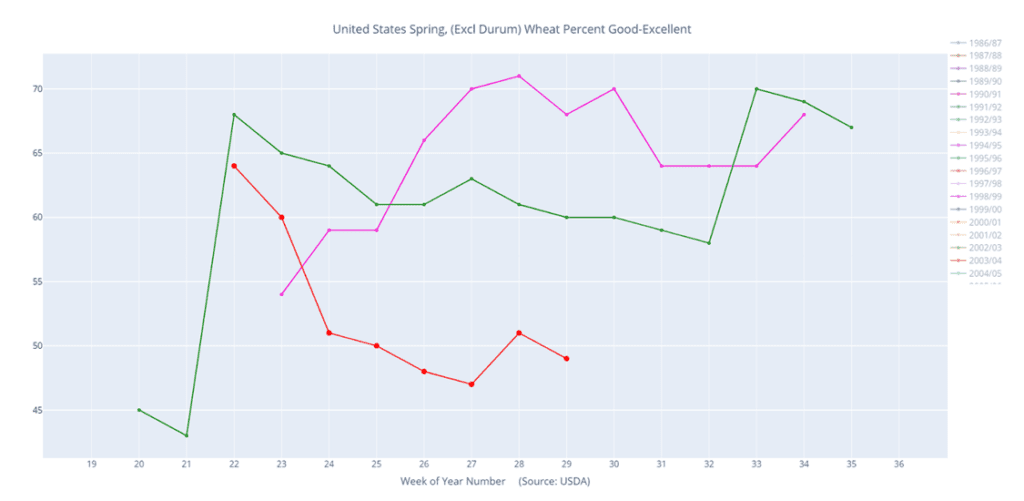
2023/24 Spring wheat condition percent good-excellent (red) versus the 5-year average (green) and last year (pink).
Other Charts / Weather
